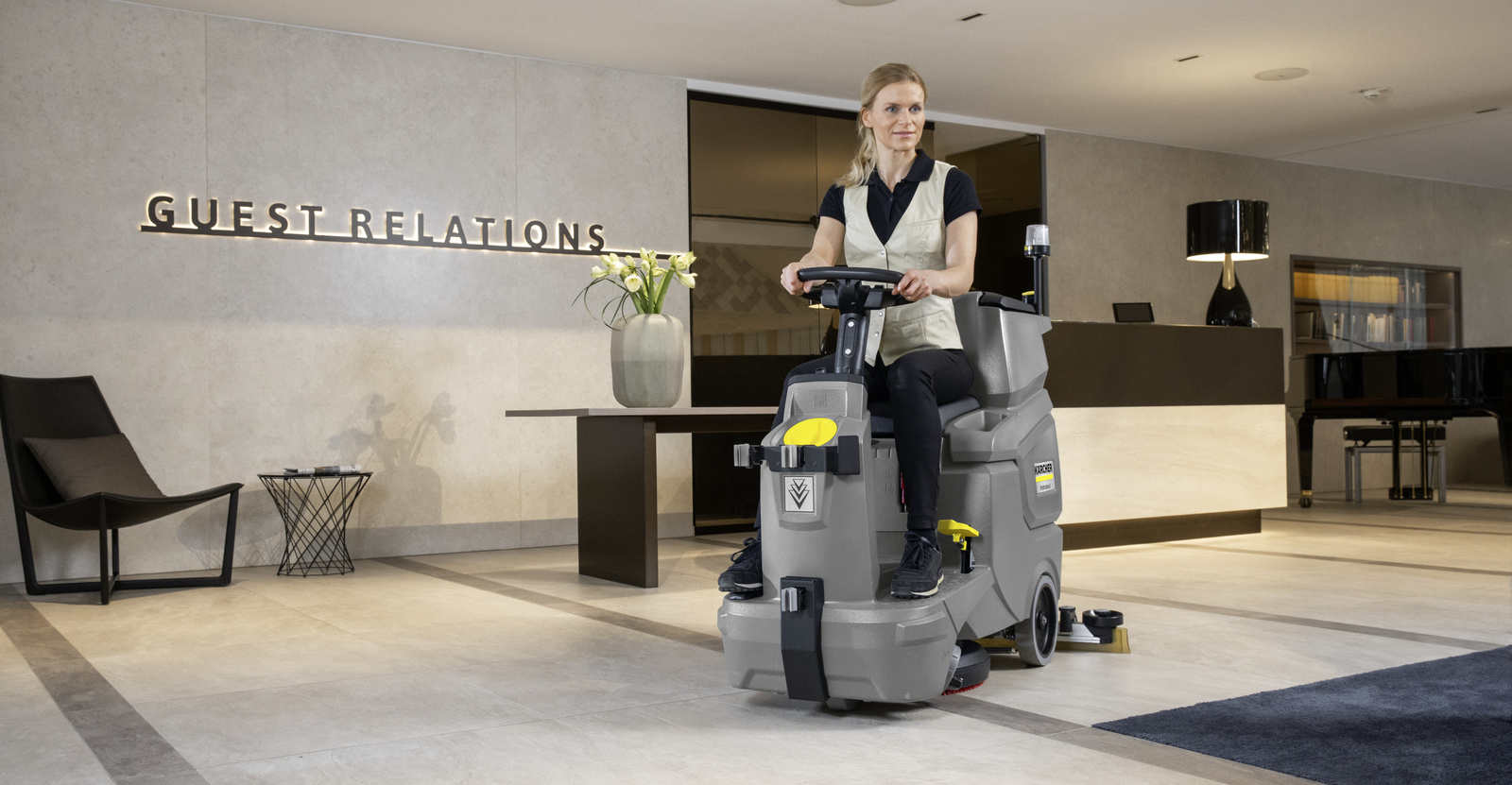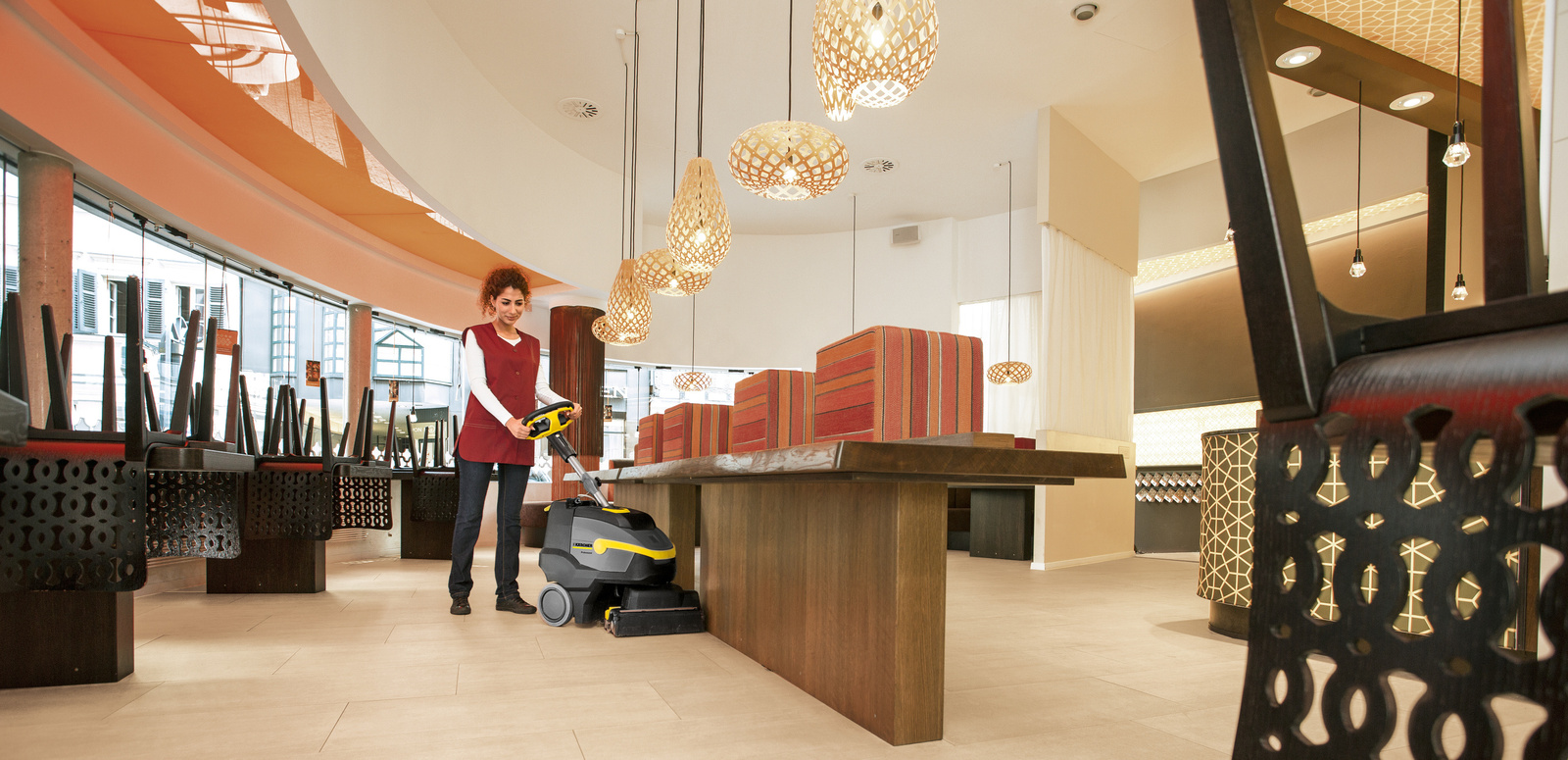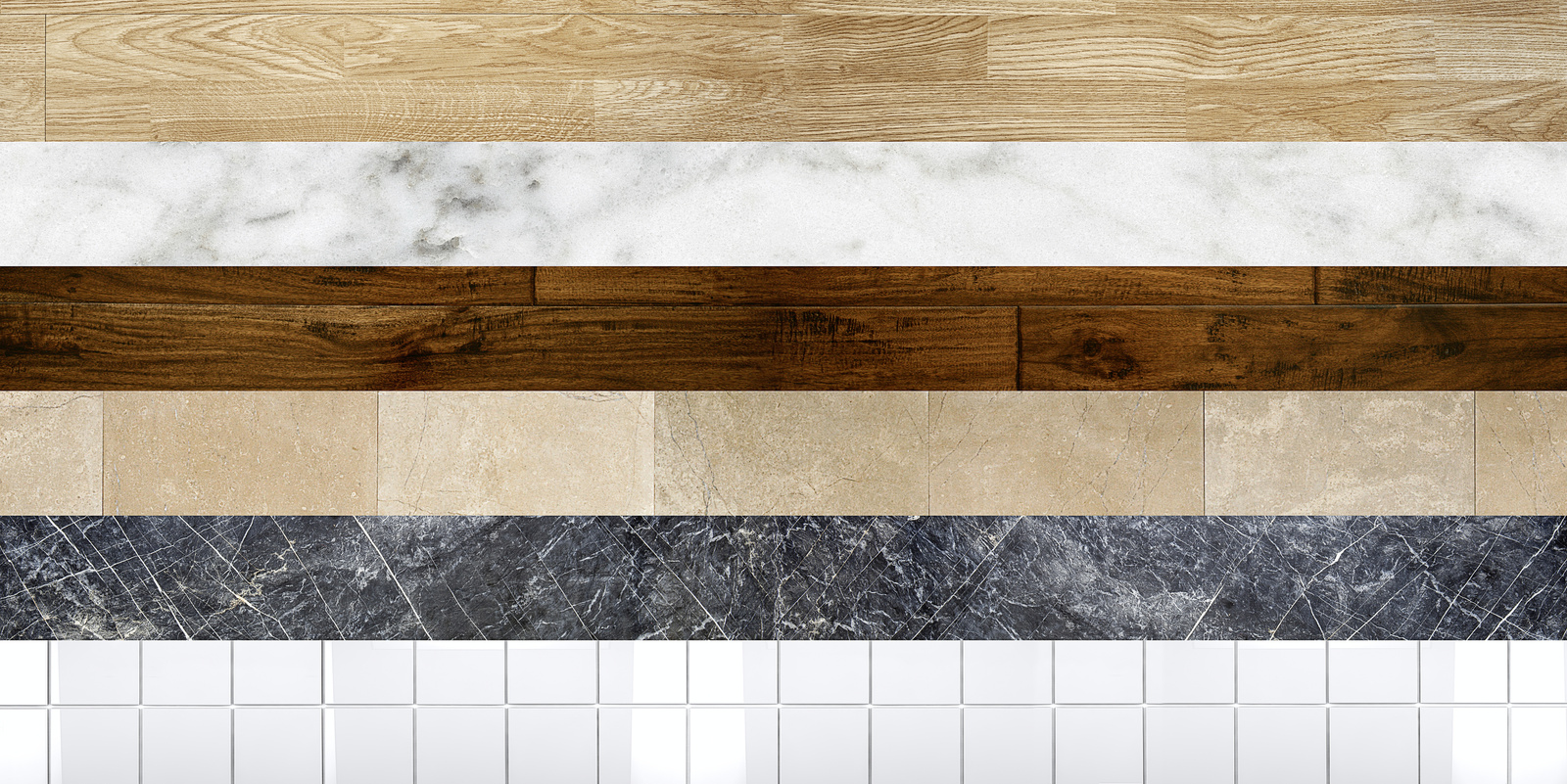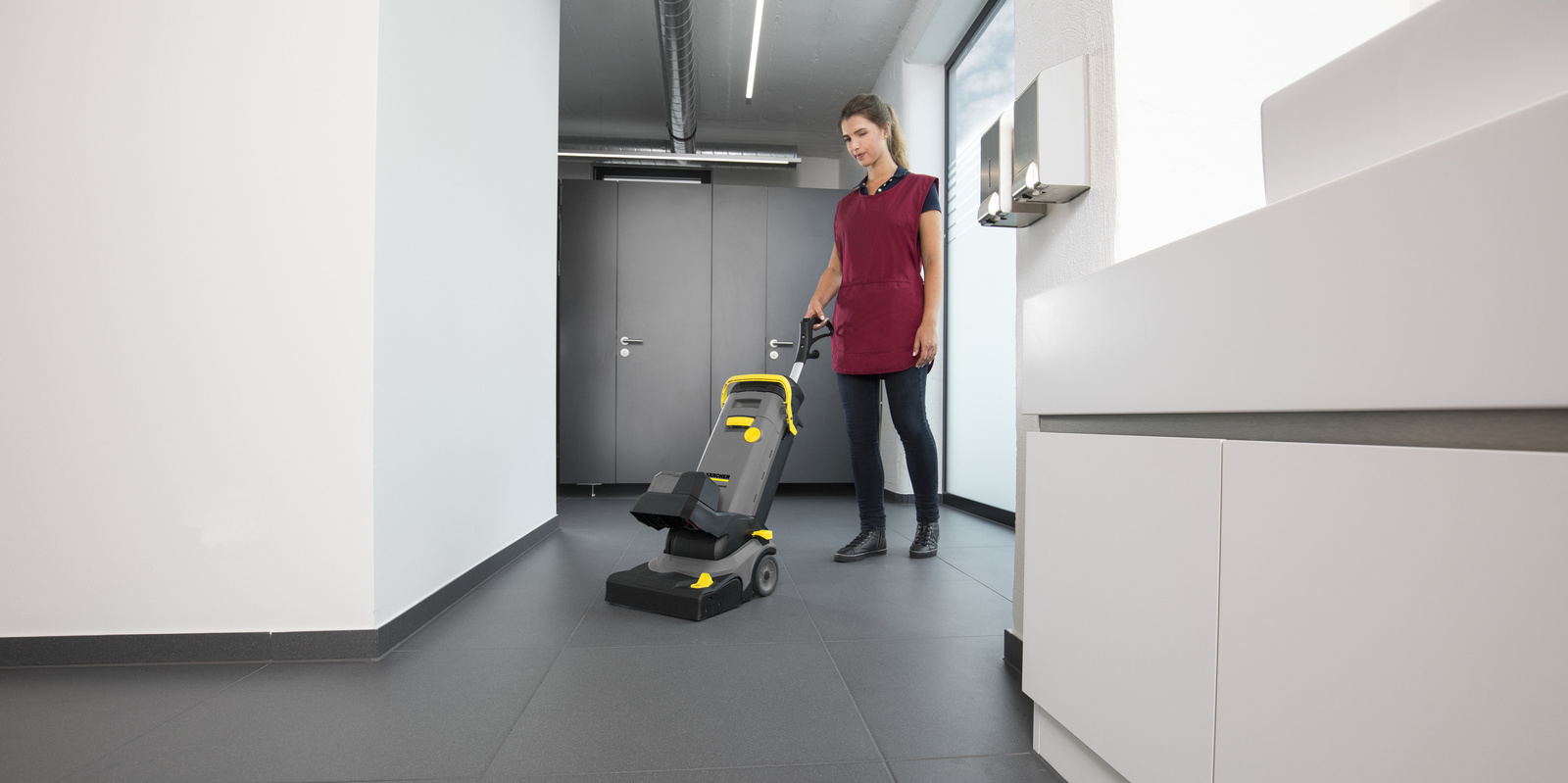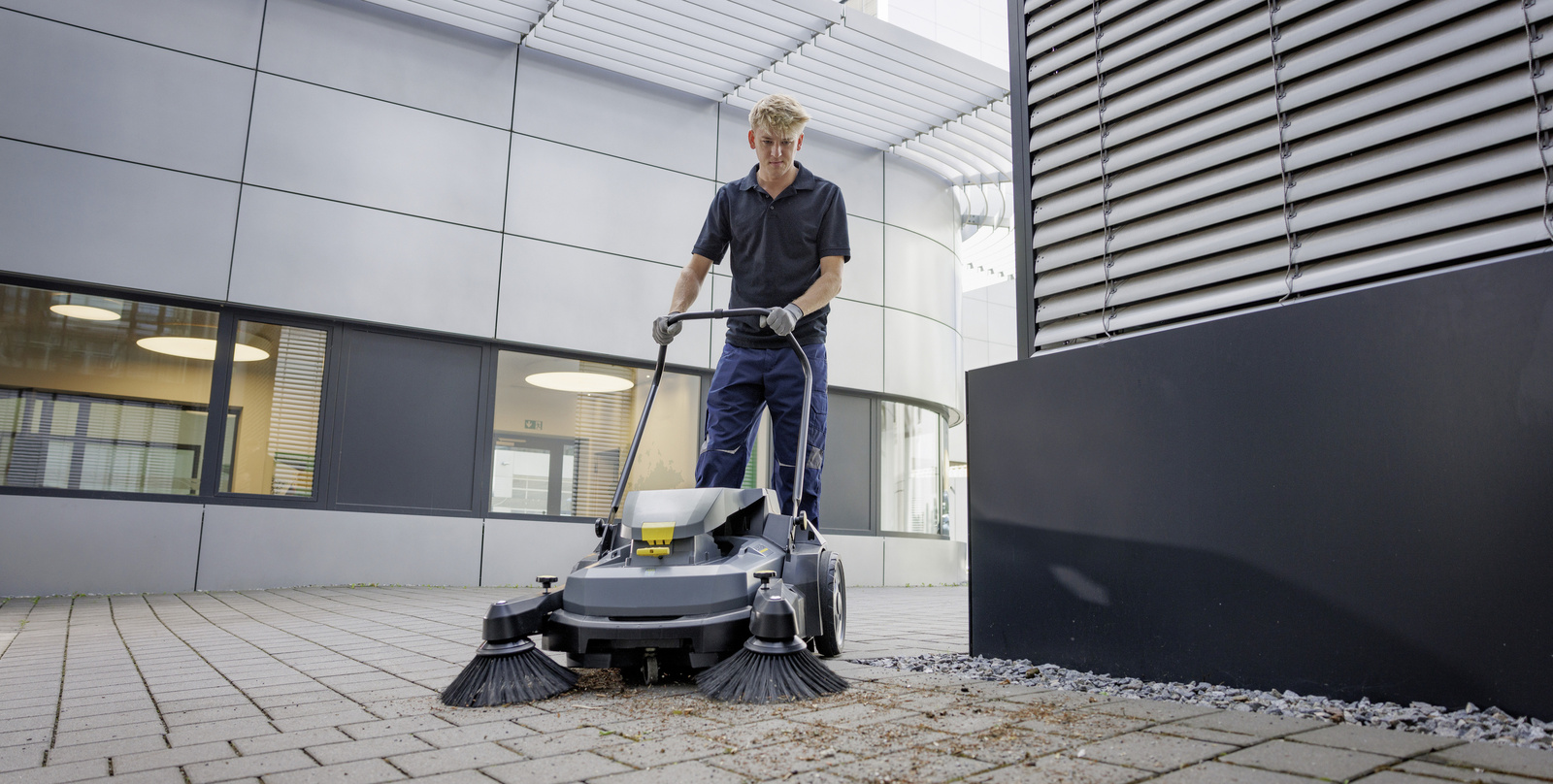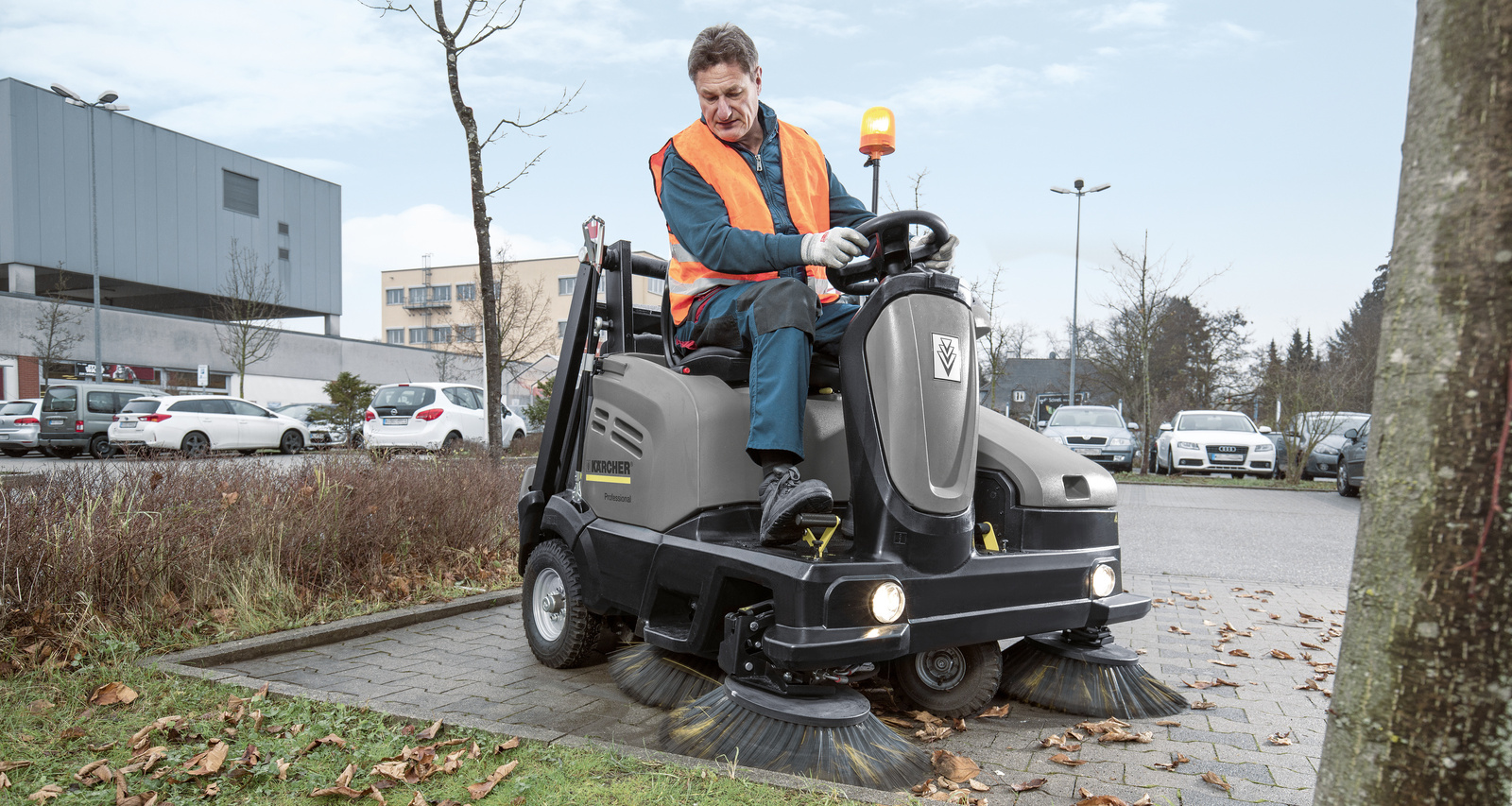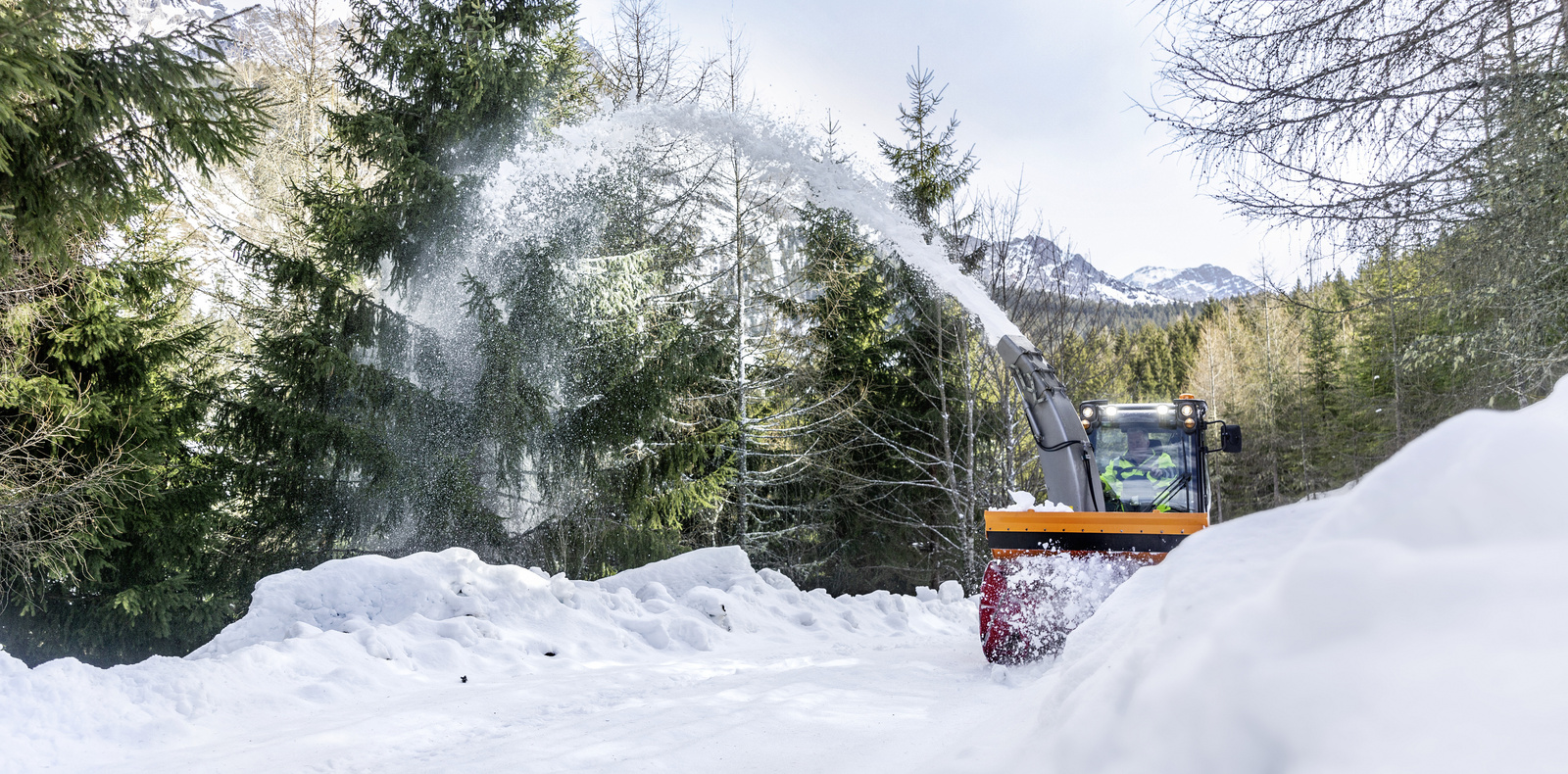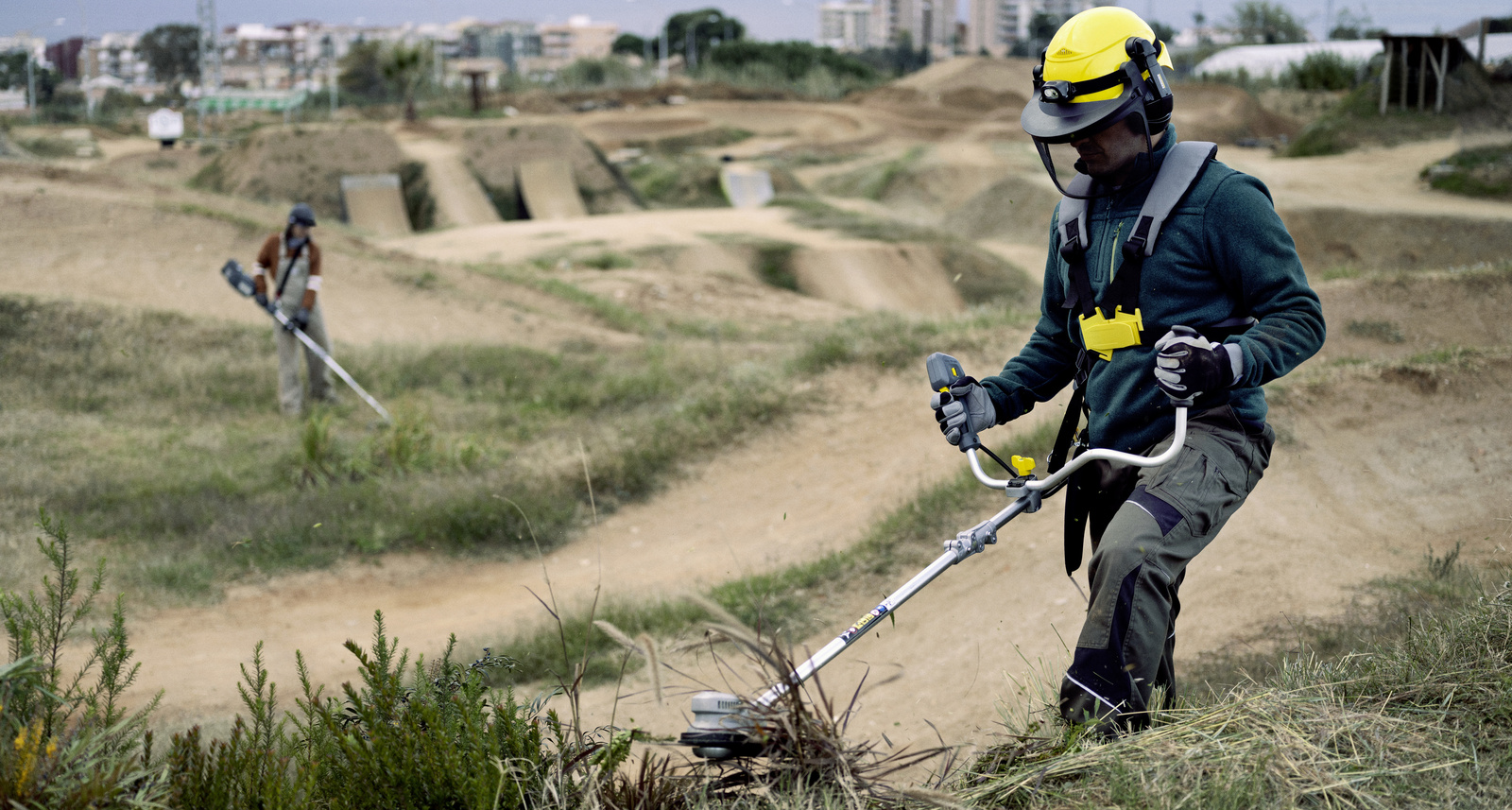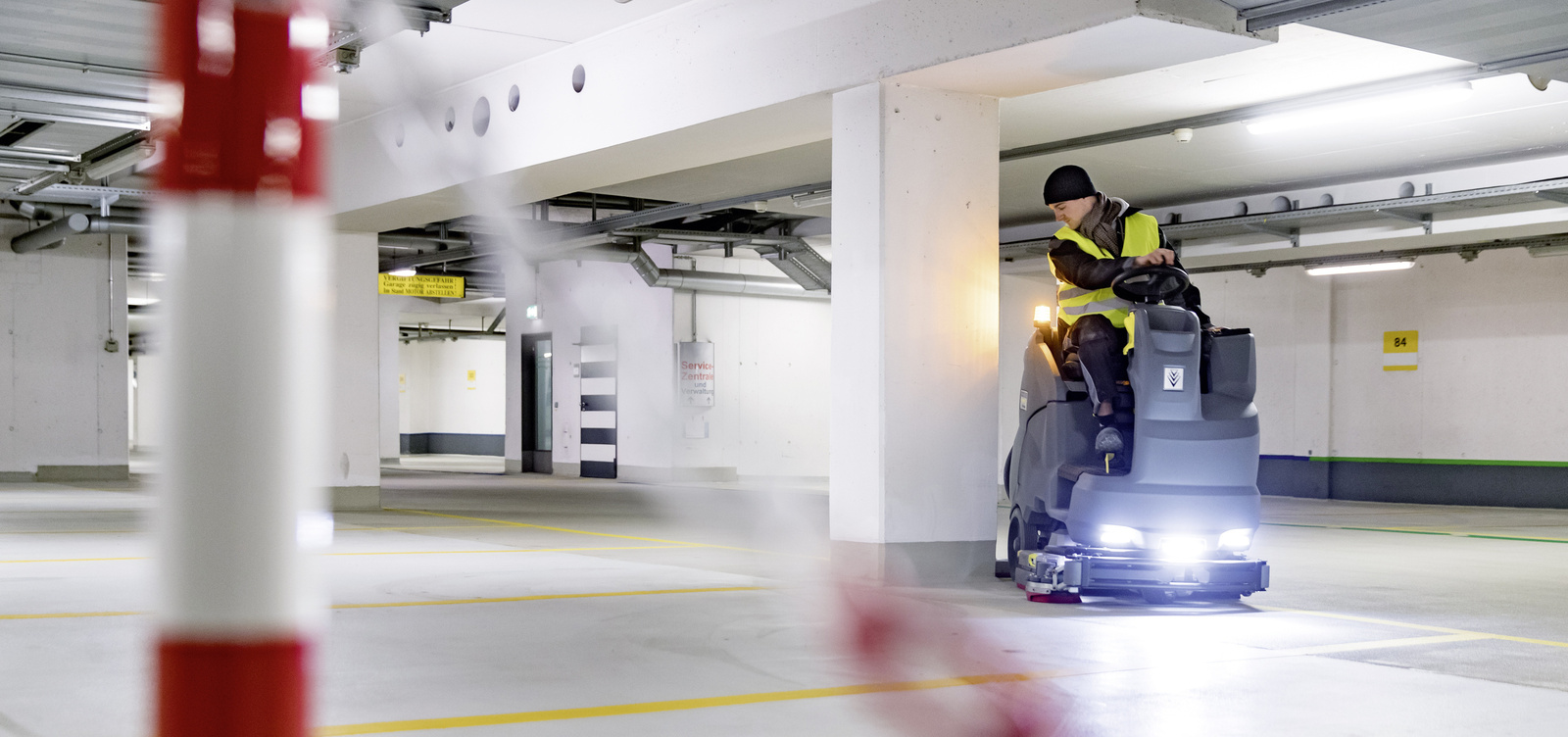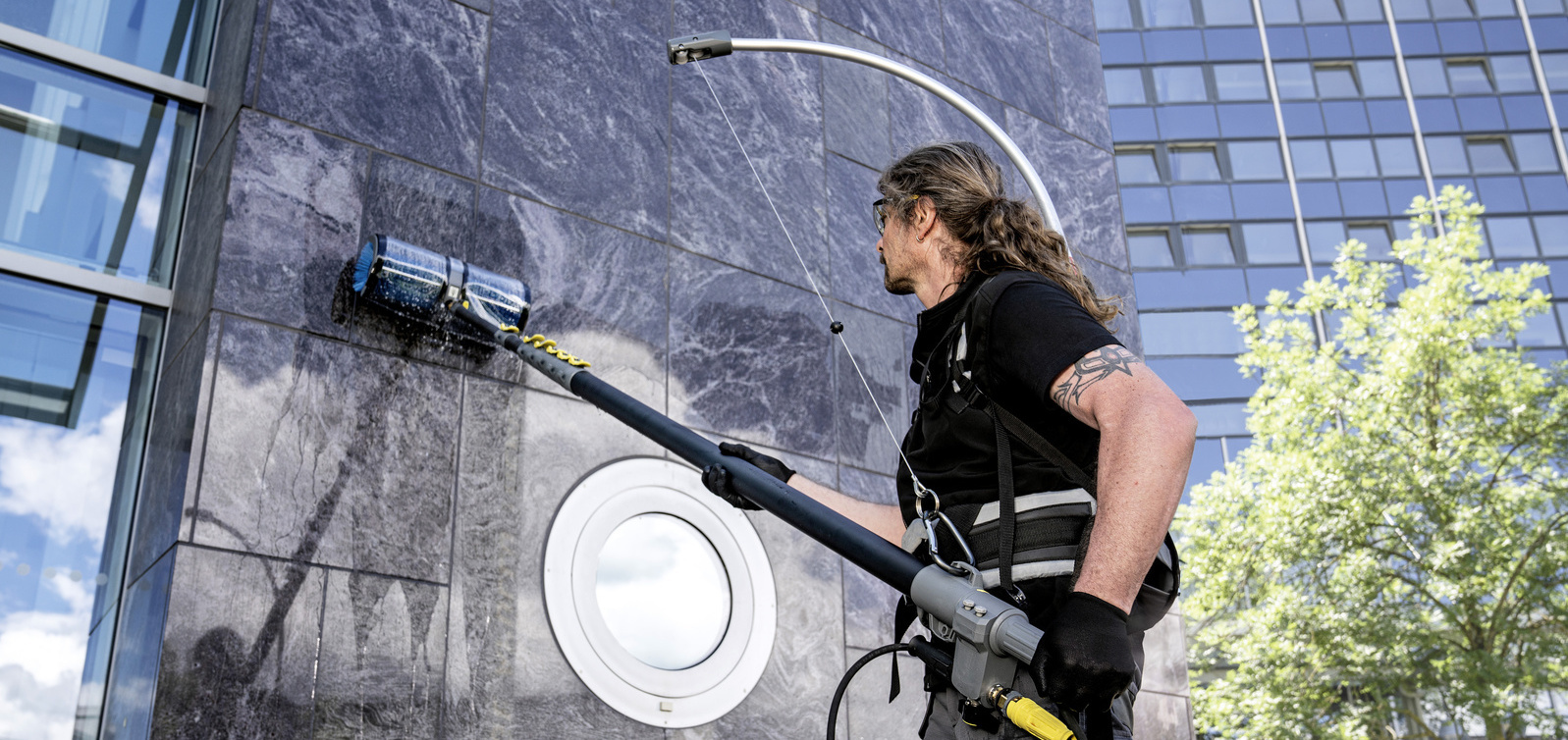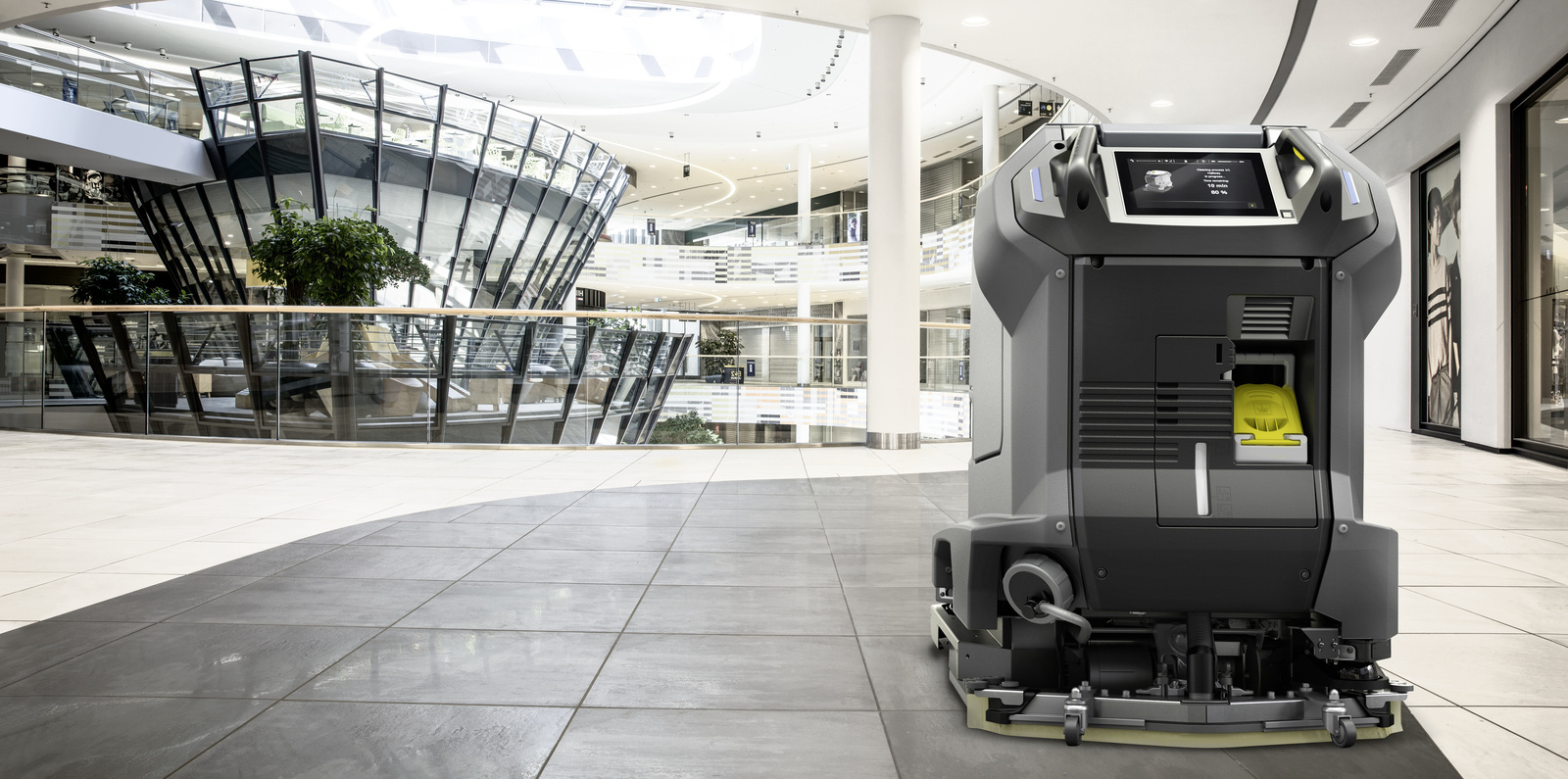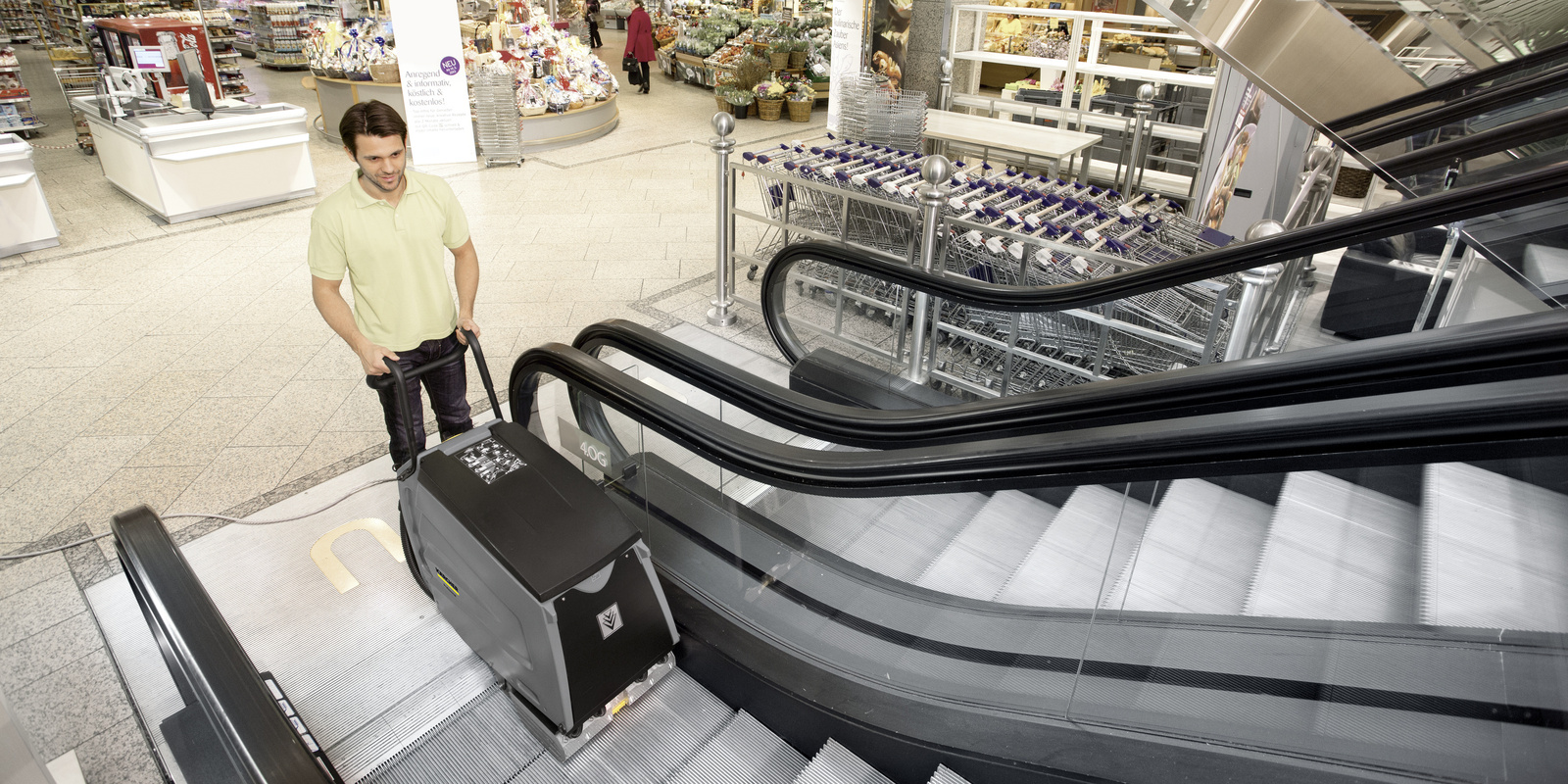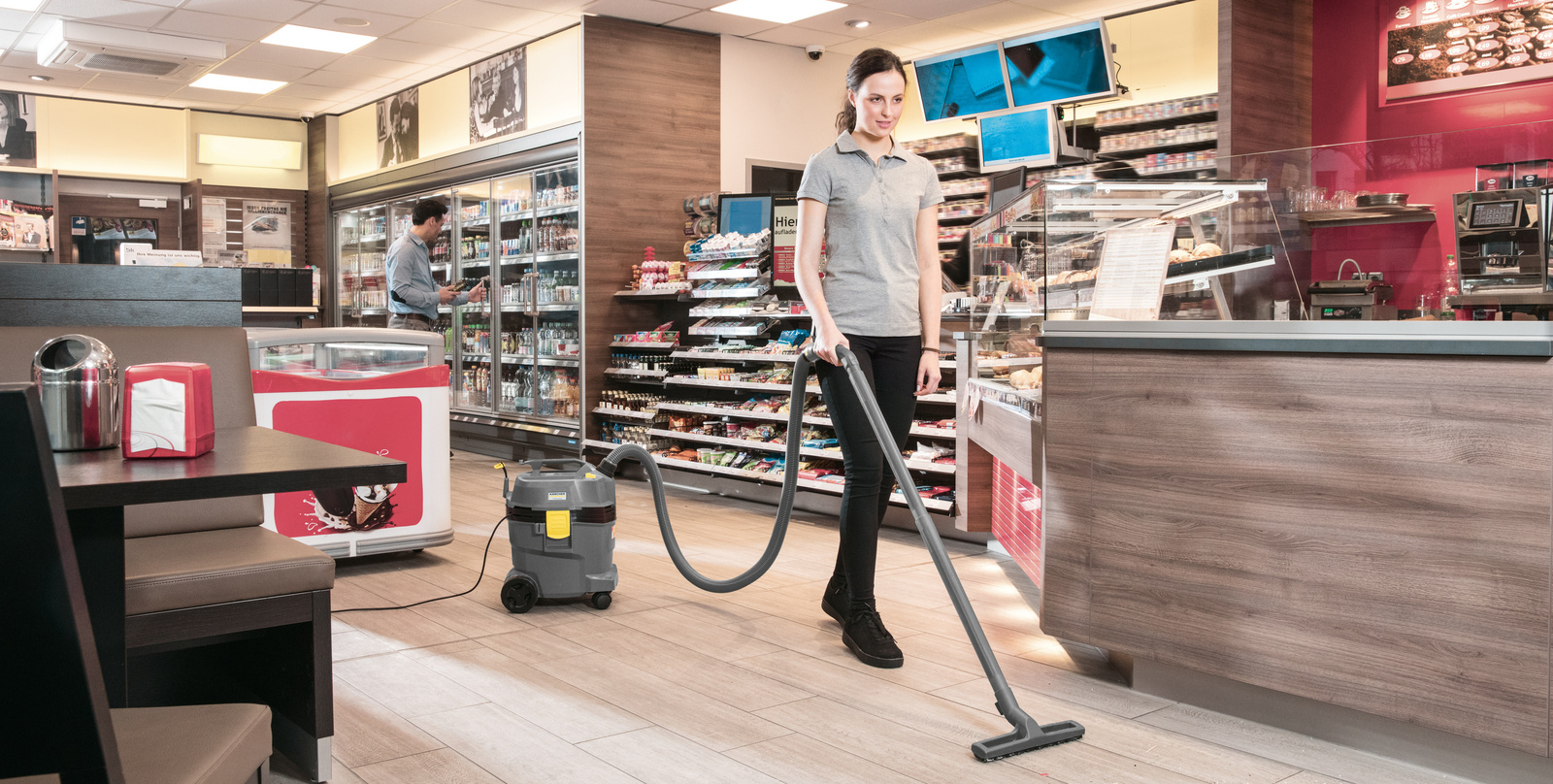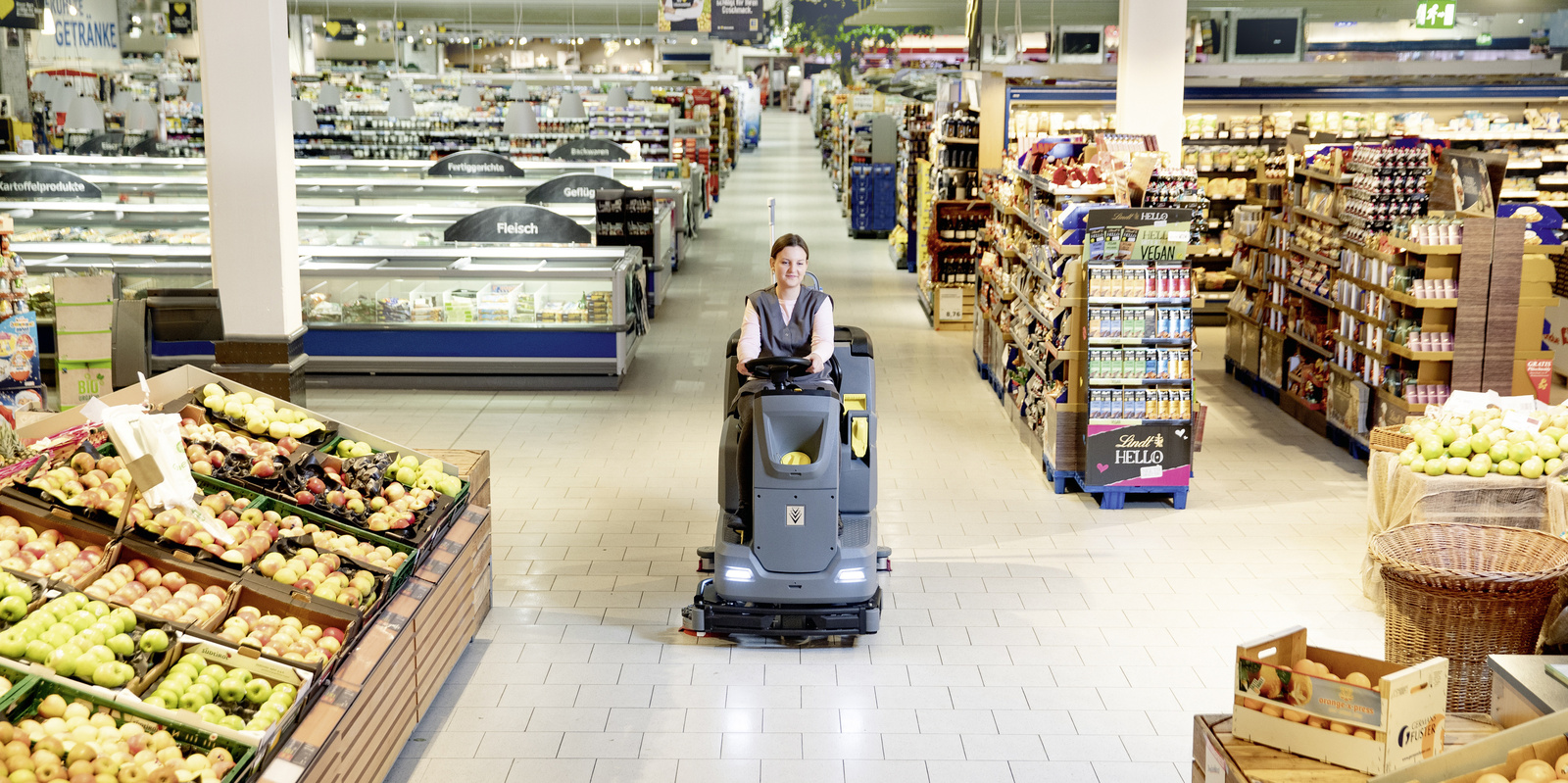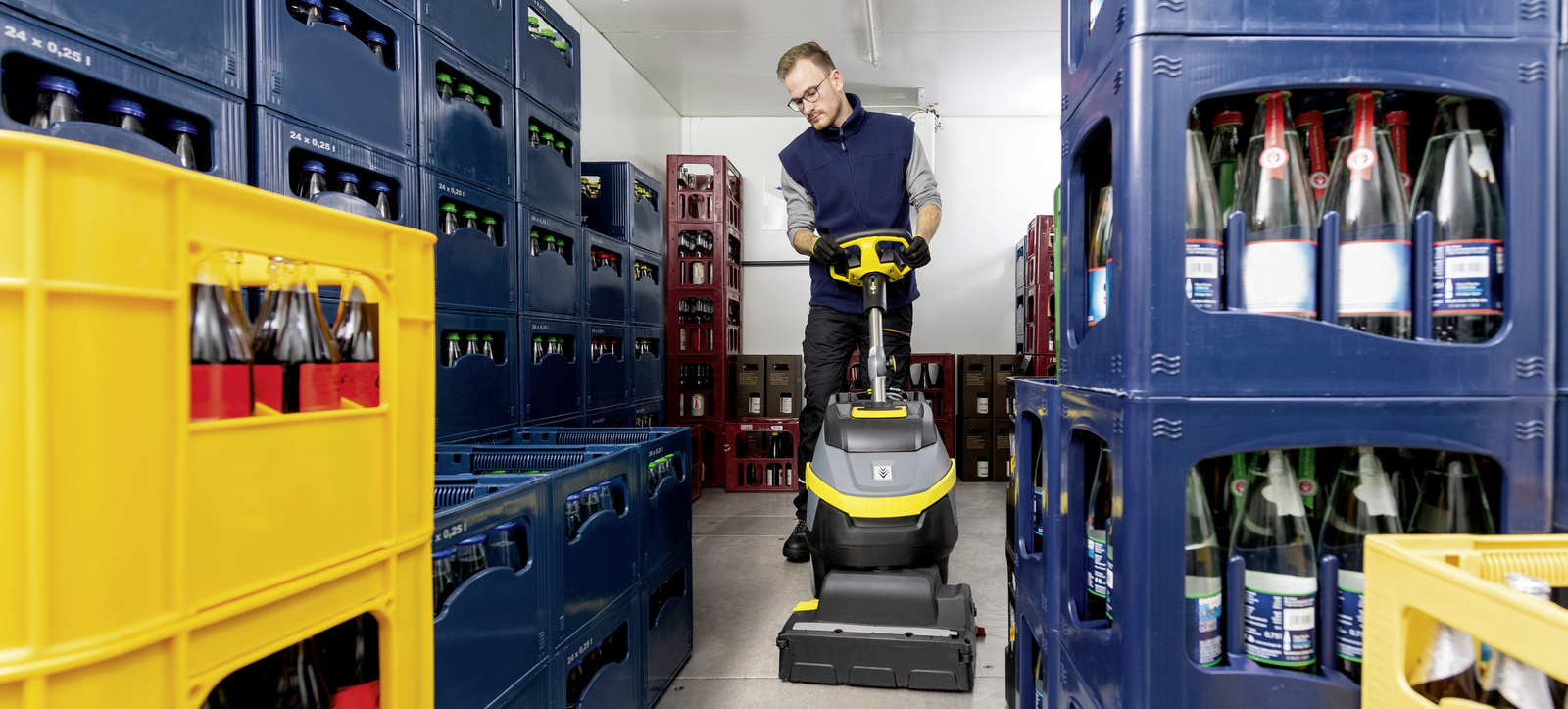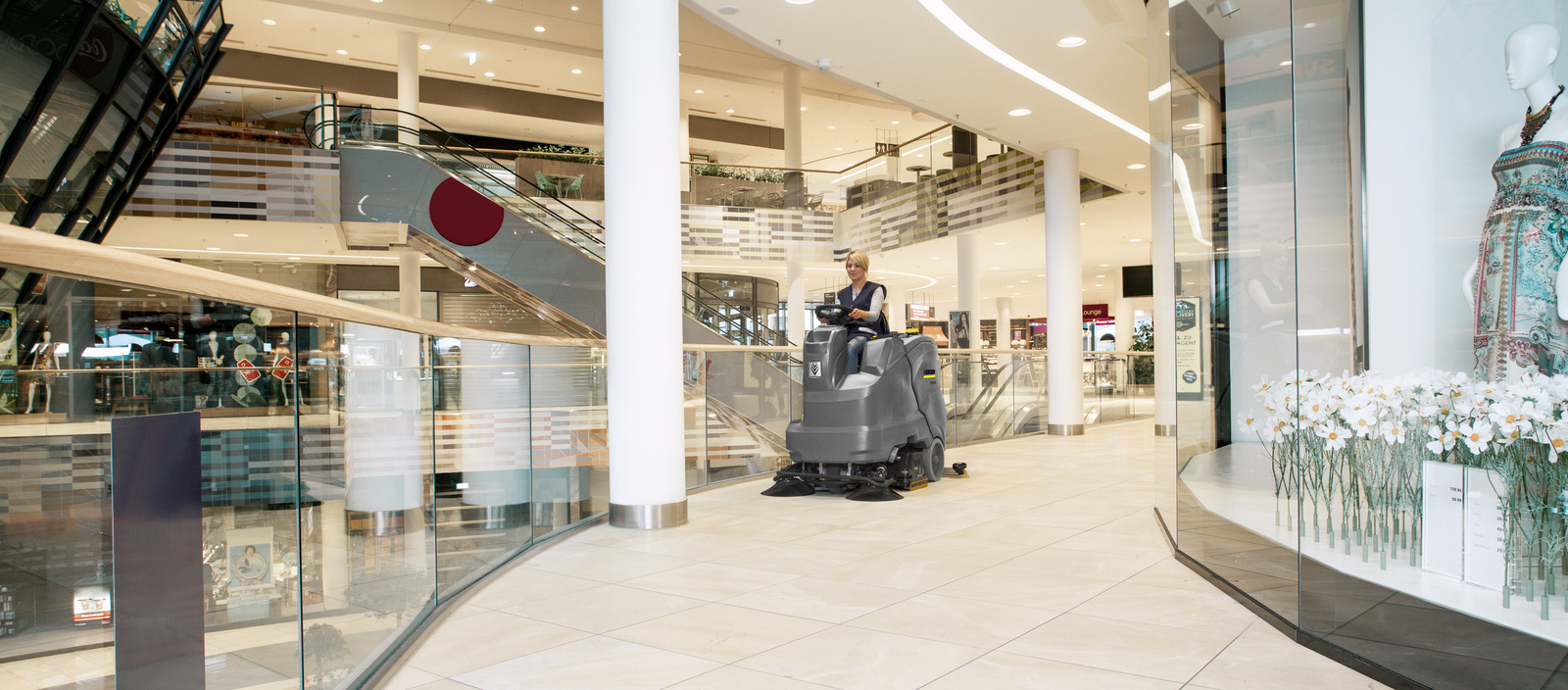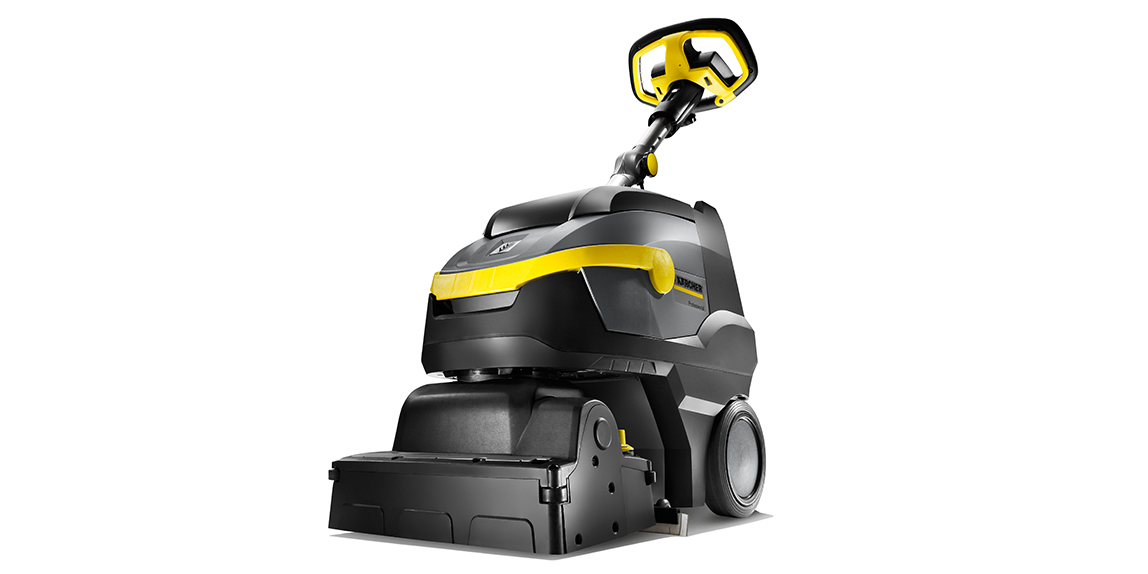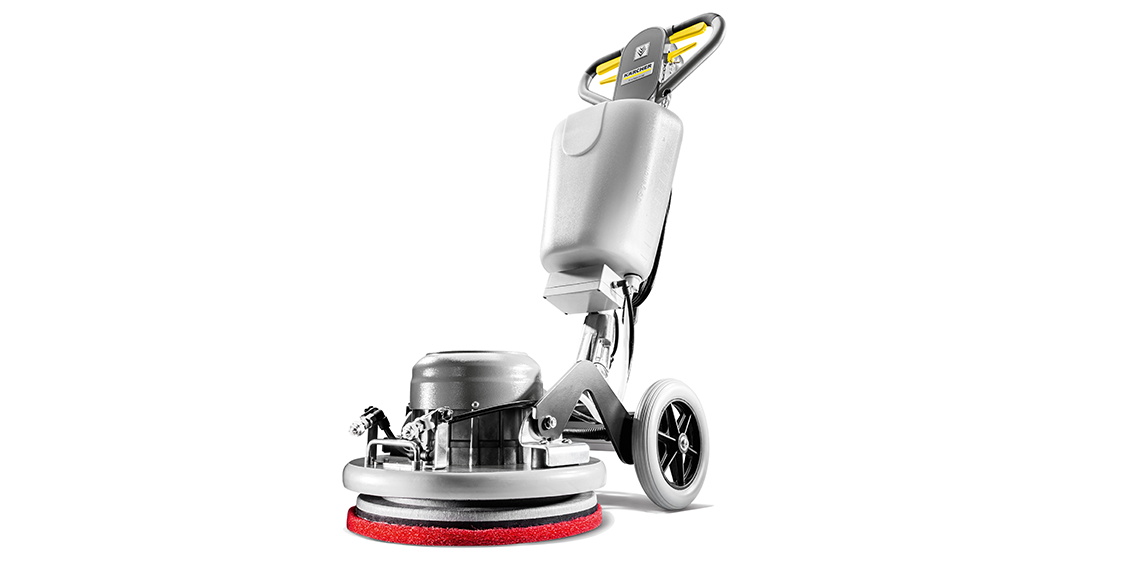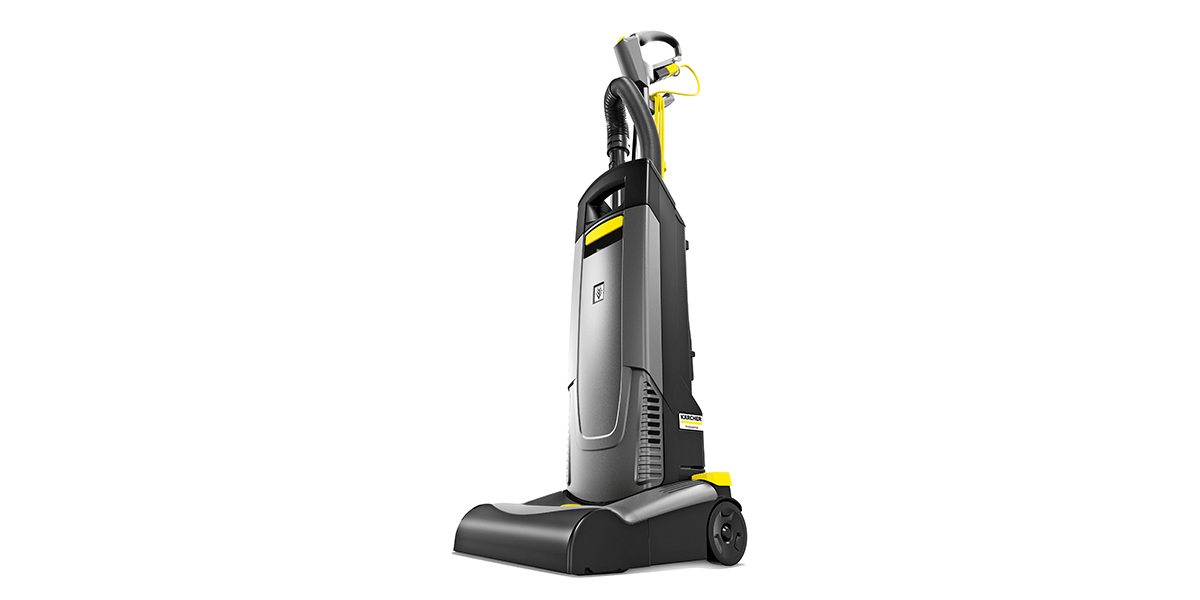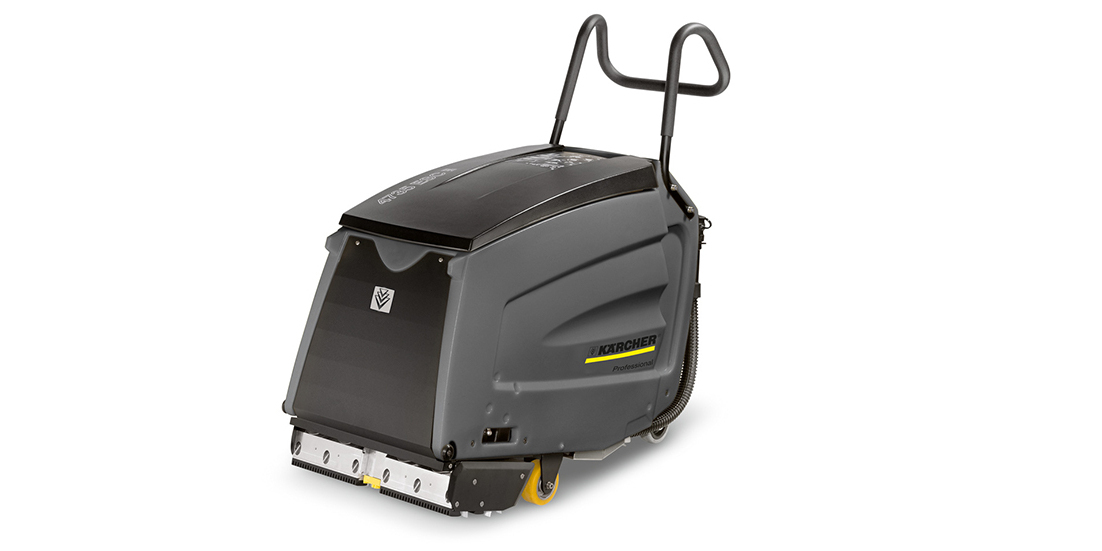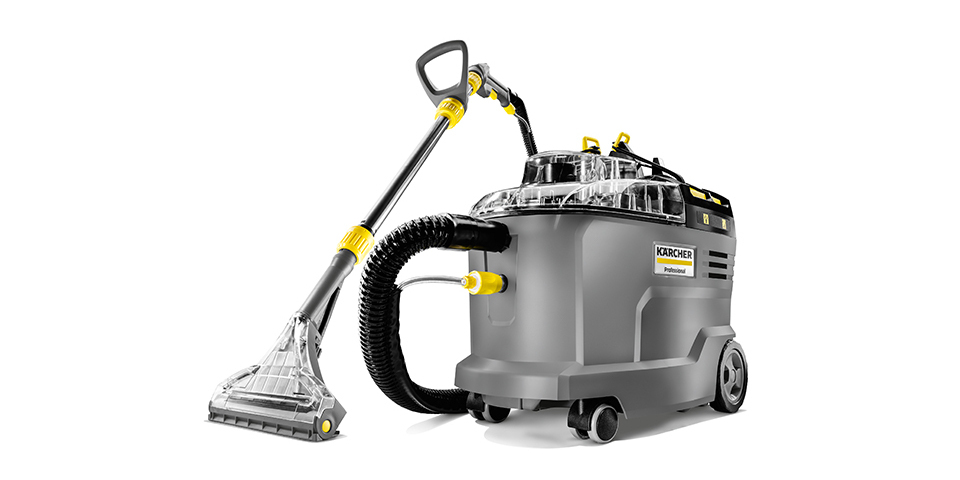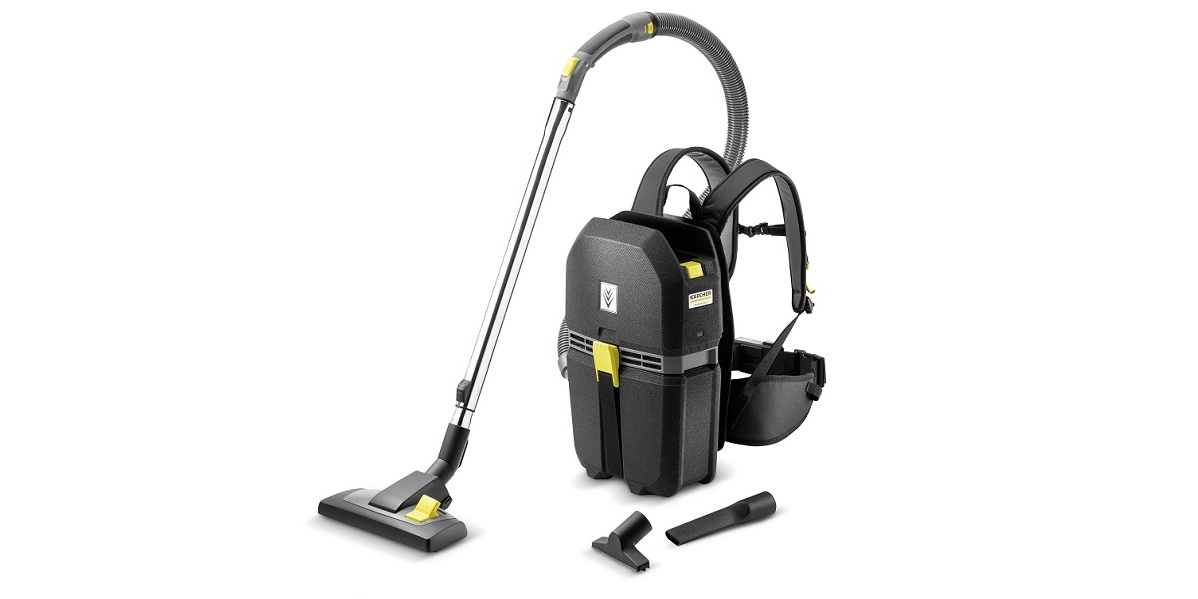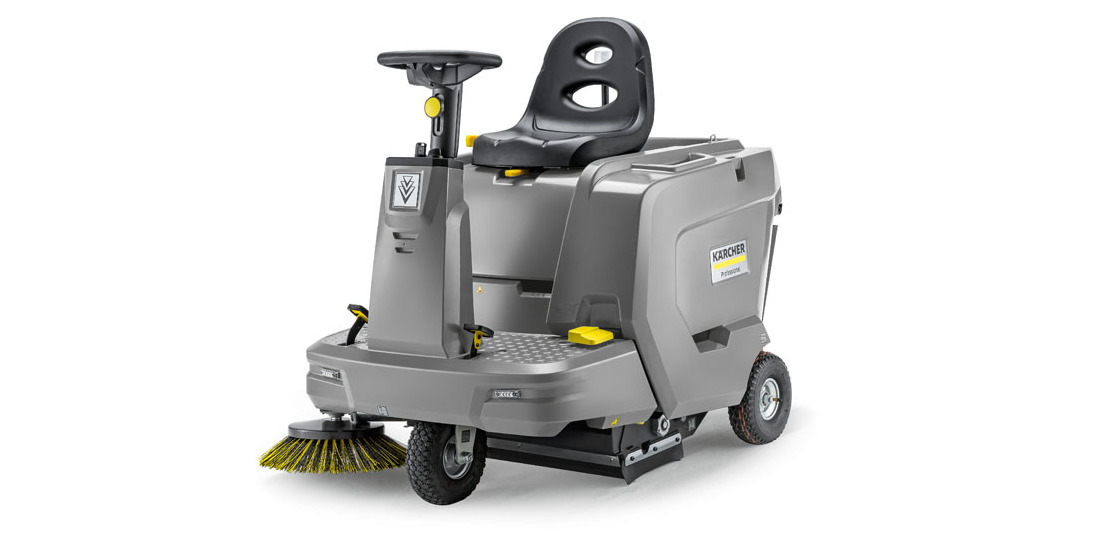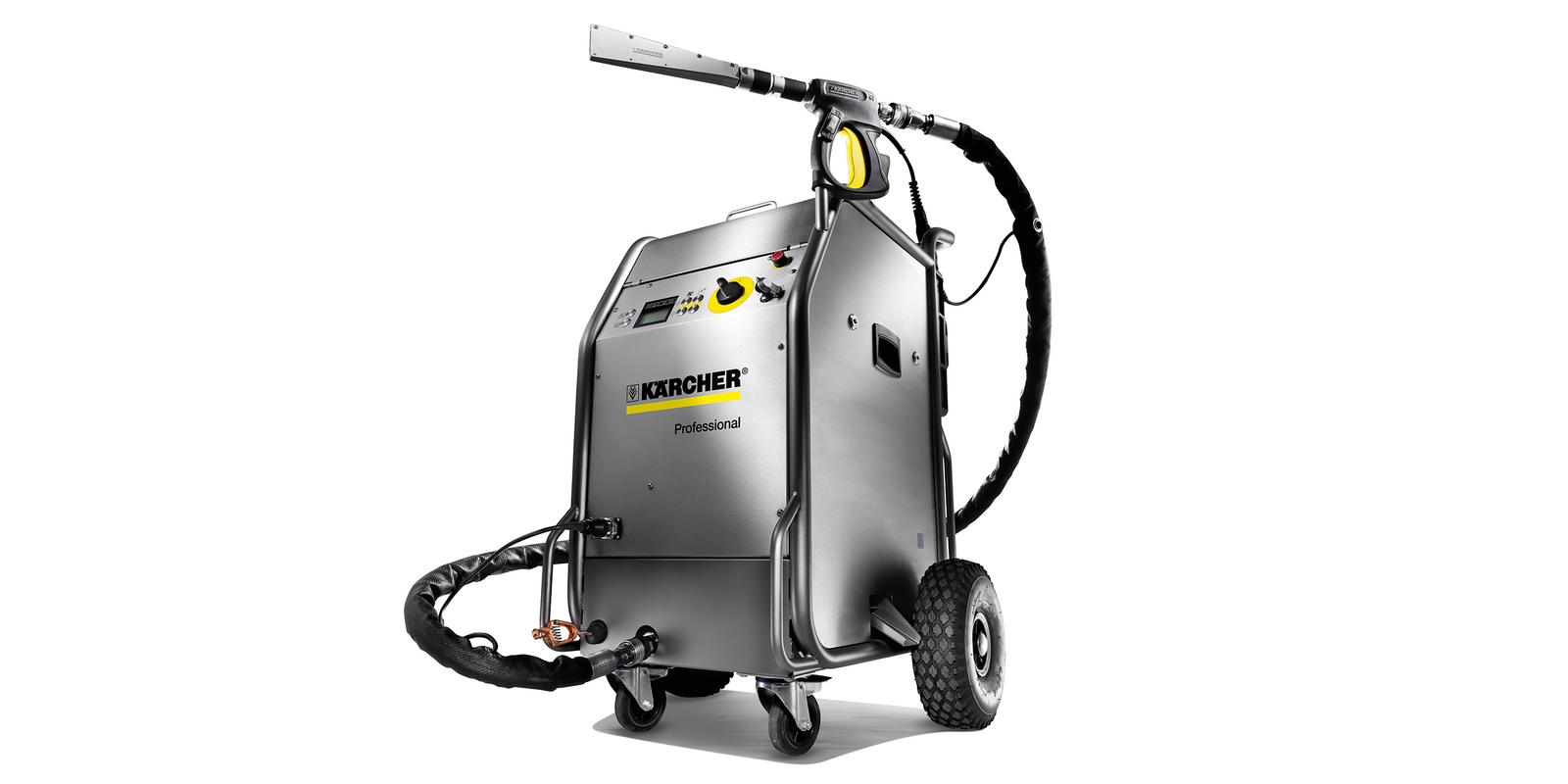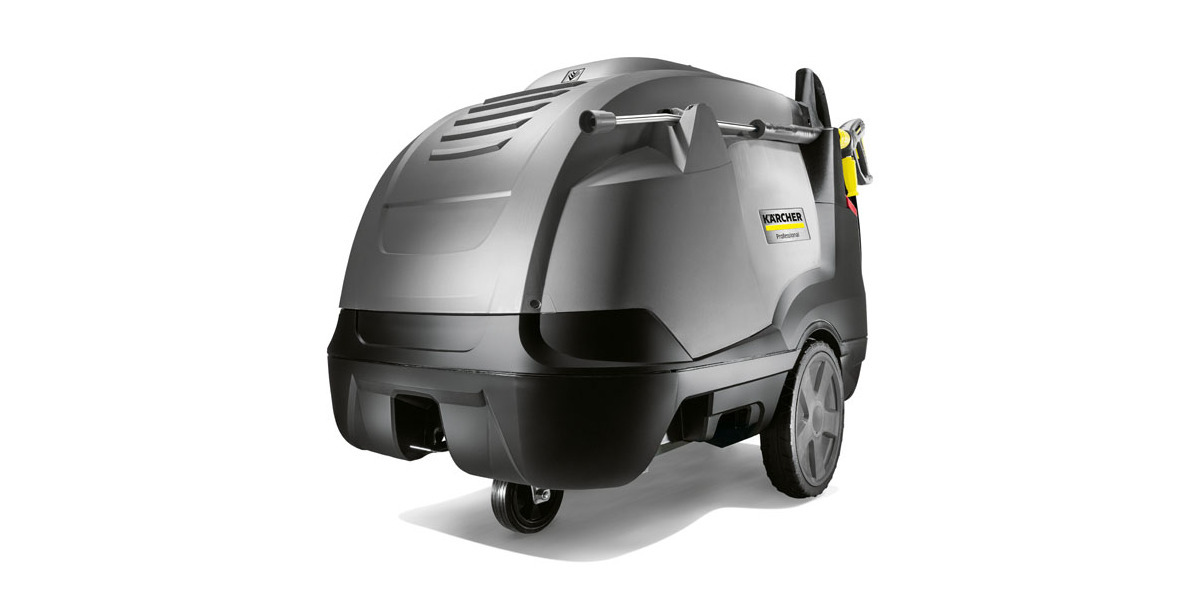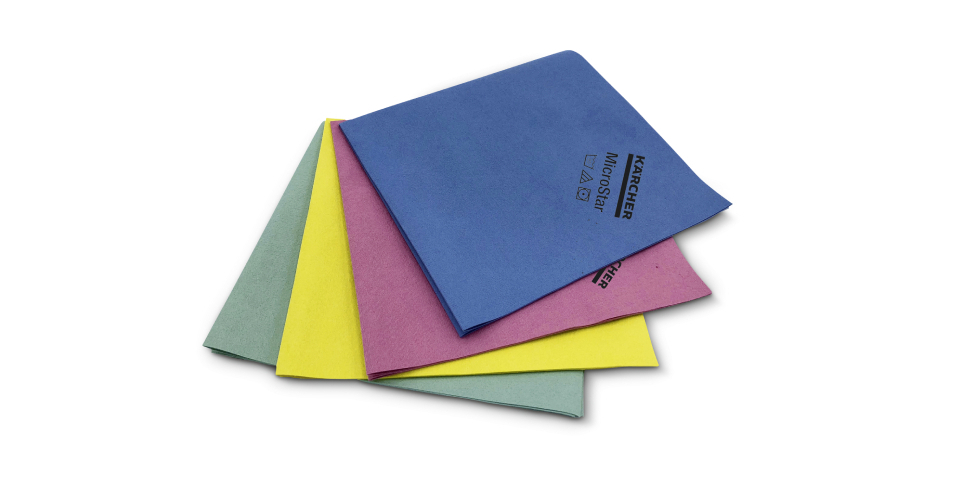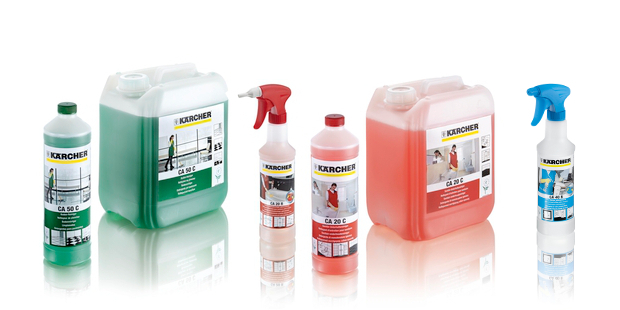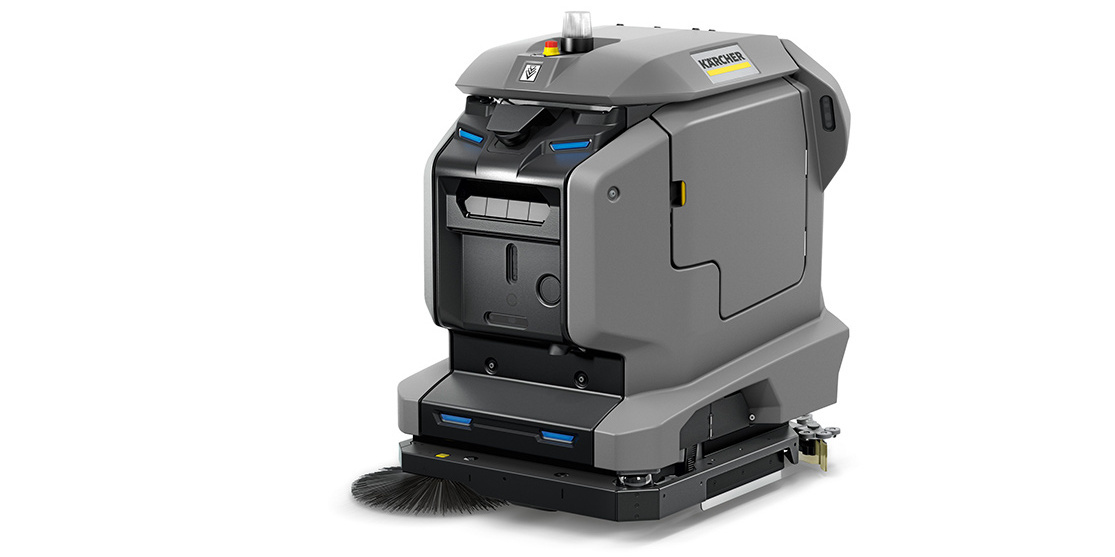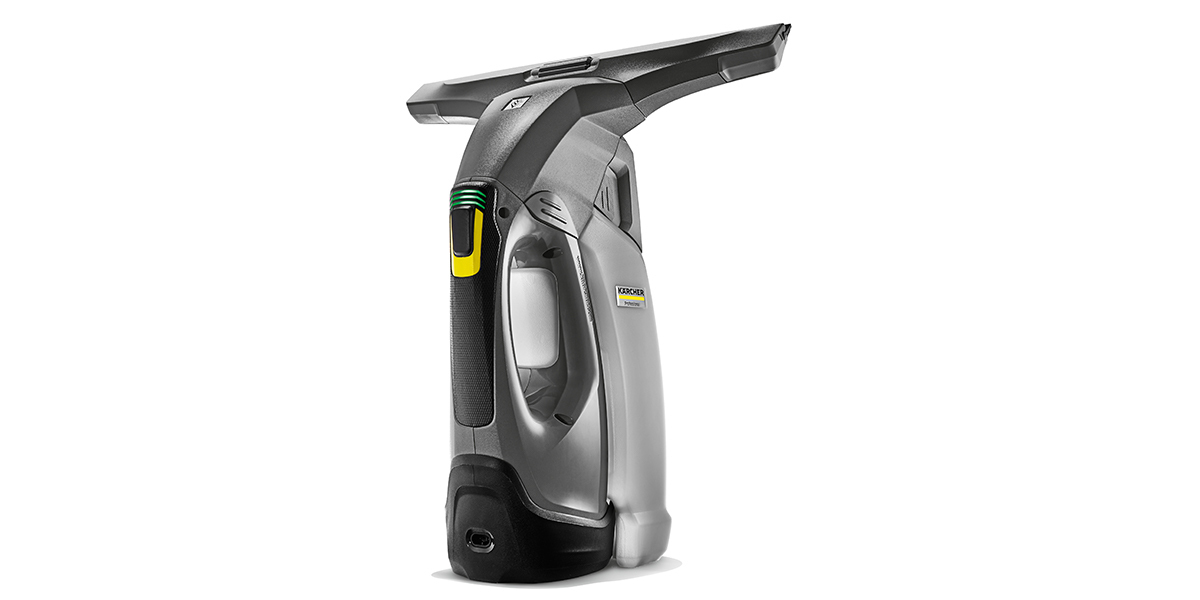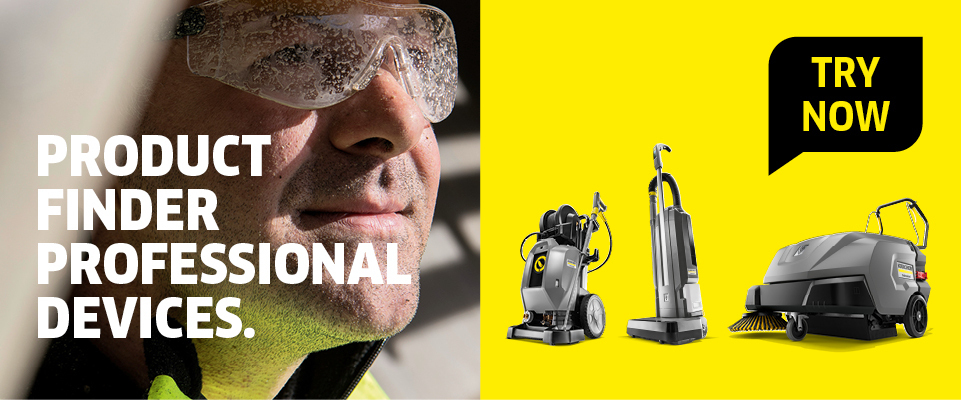Cleaning in the transport sector
Cleaning in the transport sector poses two major challenges: the lack of time and, in most cases, lack of space puts cleaning staff and customer service teams under great pressure. To avoid delays and loss of sales, maintenance cleaning in public transport vehicles needs to be a well-oiled machine in itself. The time frame available for deep cleaning is narrow and must be scheduled in advance. Achieving cleaning goals under these severe time constraints requires careful scheduling, the right methods and high-performance technology.
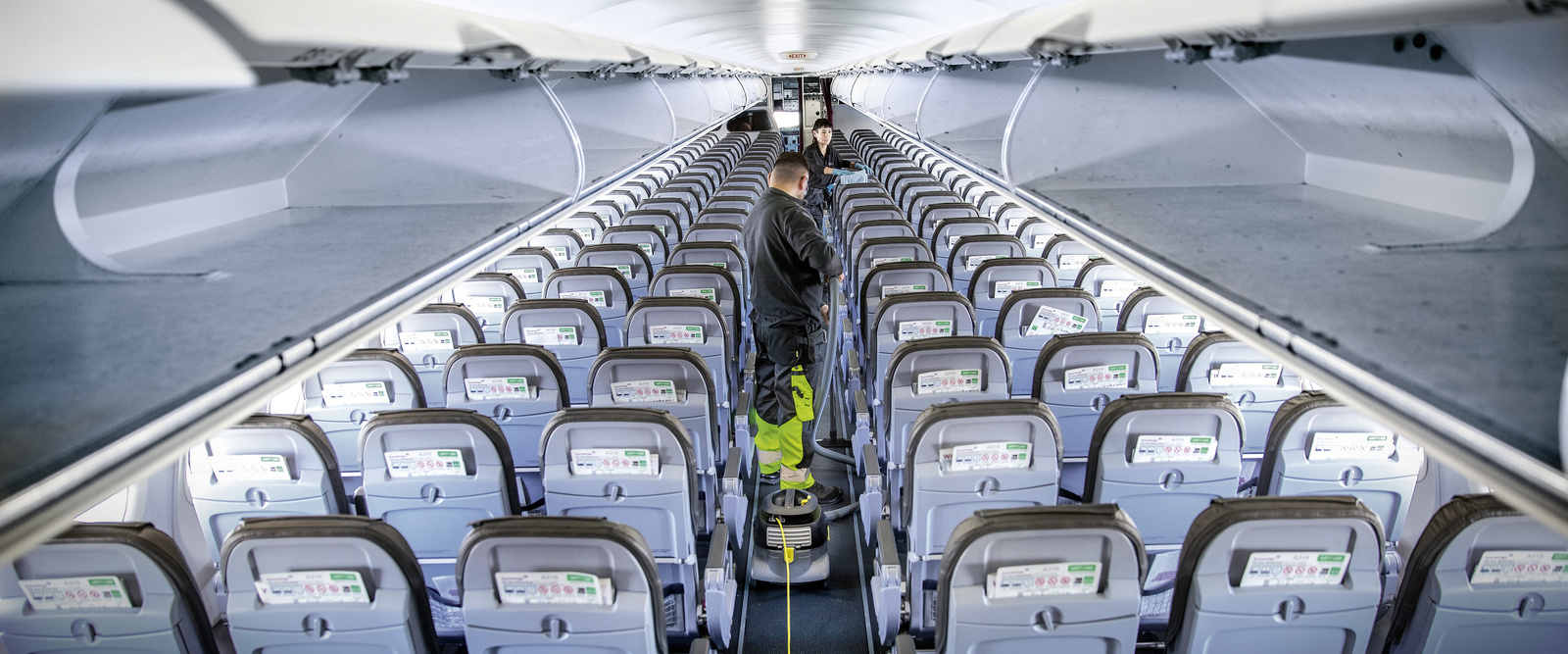
Efficient and space-saving cleaning in public transport
Public transport runs on tight schedules, is heavily frequented and often gets very dirty. Suburban trains, underground trains and buses can be cleaned quickly under space constraints using backpack vacuum cleaners, battery-powered or mini scrubber dryers and battery-powered spray extraction machines.
Suburban trains and underground trains: cleaning during operation
Suburban trains and underground trains are in almost constant use to keep the pulse of urban infrastructure going. During service hours, the easiest way to effectively remove loose dirt is with a battery-powered backpack vacuum cleaner, while more stubborn contamination can be tackled with a compact battery-powered scrubber dryer. When carrying out wet cleaning of floors in suburban and underground trains, it is especially important that the surfaces are dry afterwards so that the hard floors with quartz particles can provide sufficient slip resistance.
Tip – Hot water high-pressure cleaners:
Graffiti is a ubiquitous problem on the outer walls and windows of suburban trains and underground trains. The best way to tackle this is with hot water high-pressure cleaners.
Pulling out all the stops for cleanliness: cleaning buses
When they are not in service, buses and coaches can be cleaned in an efficient and user-friendly manner with mini scrubber dryers. These are slightly larger than a mop, but achieve a better result. This is specifically because all the loosened dirt is picked by the built-in suction. For angled surfaces that cannot be reached with the scrubber dryer, microfibre mop covers with suitable holders can be used instead.
Battery-powered spray extraction machines are a good choice for cleaning the upholstery of seating. Even stubborn, dried-on drink stains and food spills don't stand a chance against these. The procedure for using these is simple: first, water mixed with detergent is sprayed onto the upholstery, then it is simply vacuumed back up.



Tip – Stain removers:
Depending on the degree of soiling, the process can be repeated several times to remove moisture and dirt from the surface with each pass. A stain remover can also be used to spot clean stubborn stains.
Keep cleaning operations on track: cleaning trains
A procedure known as Japanese cleaning can be used to efficiently clean trains while they are in service. When surface cleaning is required, the use of the right method will effectively eliminate germs. Carpets and upholstery can be vacuumed during breaks in service and fully deep cleaned during extended periods of non-operational time.

Japanese cleaning: matching the rhythm of rail traffic
To enable the daily cleaning of visible dirt while trains are in service, a special method known as Japanese cleaning is sometimes used several times a day. For this process, one employee waits at each door of the arriving train, gets in when it stops, cleans the section up to the next door and then leaves the train again. This allows coarse dirt to be collected and carpets to be cleaned with battery-powered brooms or upright brush-type vacuum cleaners.
Surface cleaning: end of the line for germs
The pretreatment or spraying method is recommended for surface cleaning, and for two good reasons: firstly, it prevents the spread of germs, since the cloths are not soaked in the same cleaning solution over and over again. Secondly, there is no need for a bucket to be transported in the narrow compartments. For this process, cleaning staff use twice-folded cloths that have been presoaked with the right amount of detergent. Alternatively, a foam dispenser can be used to apply the cleaning solution directly to the prepared cleaning cloth. After the first surface has been cleaned with the first side of the cloth, the cloth is unfolded for each subsequent surface until all sides have been used. The cloth is then discarded and a new one is used.
Tip – Cleaning without drips or slips:
Battery-powered window and surface vacuum cleaners are ideal for cleaning windows, since they vacuum the dirty water straight back up so that it does not drip onto the floor. This minimises the risk of slipping.
Orbital machines and spray extraction for carpets and upholstery
Intensive cleaning of carpets is usually scheduled for the nighttime or other breaks in operation. The aisles are cleaned using oscillating orbital machines together with a microfibre pad and surfactant-free detergent. This achieves excellent cleaning results. In between times, upholstery can be vacuumed, or drink strains, food spills etc. can be easily removed with spray extraction machines. The more often this intermediate cleaning is carried out, the less often an extensive, time-consuming and cost-intensive deep cleaning procedure will be required, since stains do not have the chance to set in.
Deep cleaning: ensuring the entire surface is clean
Seats are often removed for the cleaning of stubborn stains, as well as for full-surface fibre-deep cleaning. Dry ice blasting delivers very good results without damaging the material. A model is available on the market that can produce the required amount of dry ice itself – ready for whenever cleaning is required. This machine can also be used effortlessly in demanding conditions with low pressure or limited air supply. In addition, it's intuitive to operative and requires no special training.
Cleaning aeroplanes and cruise ships
Time is money – especially in air travel. Teamwork is required to ensure that a plane can be cleaned between two flights in the shortest possible time. Cruise ships pose very different challenges: namely, high demands from travellers and a wide range of cleaning tasks. Nevertheless, with the right technology and the necessary expertise, cleaners needn't feel adrift in a sea of work.


Aircraft cleaning at record speed
Once an aircraft is ready for cleaning, the cleaning staff jump into action. Everything has to go hand in hand so that the aircraft is ready for boarding again as quickly as possible. On an Airbus 320, for example, six employees will board via the rear entrance. Four of them gather the rubbish in the passenger cabin so that it is ready to be collected up, and place the belts on the seats. In the meantime, one cleaner cleans the kitchen area and another cleans the rear toilets. Once these tasks are done, one cleaner collects the rubbish, two cleaners wipe down the tables, one cleaner goes around with a battery-powered vacuum cleaner and another cleans the toilets at the front.
Everything happens quickly because all these tasks have to be completed within 15 minutes – sometimes even at the same time as work being undertaken by the crew or the catering team. That's not all, either: additional tasks, such as replenishing materials in the toilets or placing airline magazines in the seat pockets, must also be carried out during this same short timeframe.


Tip – Lightweight battery-powered backpack vacuums:
Particularly lightweight battery-powered backpack vacuums are ideal for working in the cramped interior of an aircraft.
Fully on course: cleaning cruise ships
In order to meet the high expectations of passengers on these floating hotels, it's important to employ the right cleaning solution in each area. When it comes to floor cleaning alone, there are waves upon waves of tasks and materials to deal with: inside, huge areas of carpeting must be kept clean, while in outside areas, there are weather-resistant floor surfaces made of moulded plastic, often with an imitation wood finish. There are also tiled and wooden surfaces in the wellness areas, and various stone floors in restaurants and catering areas.
To keep the extensive carpeted areas clean, battery-powered upright brush-type vacuum cleaners or carpet cleaning machines are much more efficient than many small vacuum cleaners. These machines relieve the pressure on staff and produce very good results in a shorter amount of time.
For restaurants and the deck of the cruise ship itself, compact step-on scrubber dryers with disc engineering or roller scrubbing heads are a very good choice. Roller technology is ideal for textured surfaces such as fine stoneware tiles, whereas the rotating disc brush is best for cleaning and polishing smooth floor coverings.

Tip 1 – Effective carpet cleaning:
For intensive cleaning of carpets, detergent can first be sprayed on and then worked into the carpet with roller brushes. In a second step, the carpet is rinsed and the cleaning water is vacuumed back up.
Tip 2 – Short drying time:
Alternatively, encapsulation technology can be used. In this process, the detergent is sprayed over the floor covering and worked in with brushes. Due to the small amount of water used, the detergent crystallises and encapsulates the dirt, which can then simply be picked up in the next vacuum pass during maintenance cleaning. As the drying time is very short, the surfaces can soon be walked on again as normal.
Tip 3 – Useful equipment:
Particularly useful pieces of equipment include steam vacuum cleaners for saunas and spray extraction machines for the spot cleaning of carpets and upholstery.
Cleaning hotels
Cleanliness is fundamental to ensuring hotel guests are satisfied and happy to return. General awareness surrounding hygiene in hotels has increased in recent years, and the expected standards of cleanliness and hygiene in hotels have risen significantly. Parallel to this, the hotel industry is struggling with a shortage of skilled labour combined with time and cost pressures. Cleaning a hotel is a mammoth task: from the outside area to the reception desk and all the way to the floor in the spa area, every inch has to be cleaned. Carefully considered cleaning methods and suitable technology are required to make work as efficient as possible and to reduce the strain on staff. Which concepts further reduce the cleaning workload and what role can cleaning robots play?
Cleaning restaurants
Everyday working life in the hospitality industry is often hectic, with cost pressures high and staff in short supply. Yet guests' expectations are still high. To keep customers satisfied, it's not just good food that matters, but also the ambience. Cleanliness both front of house and back of house is essential to create the right atmosphere. Having the right technology and methods in place can help to complete the varied cleaning tasks efficiently and reduce the pressure on staff.
Cleaning floor coverings
Whether carpeting in a hotel corridor, cement screed in a production hall or wooden flooring in a school building, there are countless floor coverings that are suitable for different loads and ensure safety through properties such as anti-slip design or studs. Cleaning floor coverings is important in some areas to ensure hygiene, while in other areas the focus is on appearance. In any case, well-maintained floor coverings have a longer service life and therefore need to be replaced less frequently. Through regular maintenance cleaning, even the need for labour-intensive deep cleans can be delayed.
A particular challenge: cleaning toilets on public transport
Whether on a train, coach or aeroplane, toilet facilities on public transport are extremely cramped and often very dirty. Using the right method helps to work efficiently under these limited space conditions and avoids the spread of germs. Although the cleaning procedures are largely similar across the different means of transport, there are a few special considerations to be aware of in each case.


Keeping toilets clean in coaches, aeroplanes and trains
The procedure for cleaning toilet facilities in the different modes of transport is identical in most respects. Firstly, any coarse dirt needs to be swept up and disposed of. A good result can be achieved quickly and efficiently with a powerful, acidic sanitary cleaner that takes effect in a short amount of time. Pretreated cleaning cloths and mop covers are not only practical due to the lack of need for a bucket, but are also much more hygienic, since no germs are spread through the carrying around of dirty water.
The colour-coding method can also be applied to the cleaning utensils. In this method, different-coloured cleaning textiles are used to clean different areas. The signal colour of red is reserved for toilets, urinals and splash areas. Yellow cleaning textiles are used for all other areas of the facilities.
To prevent streaks from forming when cleaning the mirrors, we recommend using suitable microfibre cloths together with a ready-to-use glass cleaner.
In aeroplanes, trains and coaches alike, consumables such as toilet paper, soap and disinfectant will always need to be replenished once cleaning is complete.
Although there are many similarities in terms of the methodology and equipment used in the different means of transport, the exact processes vary depending on the type of vehicle. In coaches, the driver is often responsible for the cleanliness of the toilet facilities during the journey. For aeroplanes, a suitably equipped cleaning trolley is usually on standby in the passenger boarding bridge so that the work can be completed in the allocated timeframe between two flights.
Tip 1 – Protective equipment:
When handling microfibre cleaning textiles or detergents and disinfectants, it is essential to wear gloves and, if necessary, additional personal protective equipment.
Tip 2 – Efficient deep cleaning:
A mini scrubber dryer is well suited to cleaning the floors of toilet facilities as quickly as possible in limited space during deep cleaning.
Cleaning toilet facilities and washrooms
There are many reasons why careful cleaning is required in toilet facilities and washrooms: depending on the setting, toilets, showers and changing rooms in office buildings, production facilities, hotels, restaurants, sports halls or shopping centres are used by many people. This inevitably leads to people's skin coming into contact with various different surfaces that have been touched by practically all users of the facilities – including door handles, taps or toilet flush buttons. Consequently, microorganisms can pass from one person to the next. This must be prevented by means of defined cleaning sequences.
Cleaning the infrastructure (1): cleaning airports
Cleaning the means of transport itself is by no means the end of the story – airports with car parks and outdoor areas, check-in desks, waiting areas and more besides also need to be well maintained in order to offer visitors a pleasant experience on their travels. Floor cleaning alone is a mammoth task that can still be accomplished in the midst of foot traffic with the aid of suitable equipment and robotic solutions.

Clean landing: outside areas and car parks
In order to give passengers and visitors a good impression as soon as they arrive at the airport and reduce the amount of dirt that gets into the building, a well-maintained outside area is key. Depending on the weather conditions, different technical equipment is available to make the work more efficient. When the weather is warm and dry, car parks, access roads, ramps and footpaths can be cleaned using vacuum sweepers. Push sweepers or ride-on models are ideal for picking up loose dirt from paths, multi-storey car parks, parking spaces or entrances.

Scrubber dryers are a good solution for cold and wet weather conditions, as well as for salt and stubborn dirt. Leaf blowers can be useful for removing rubbish, coarse debris and leaves. Battery-powered variants have the advantage of being quieter and therefore less disruptive. They are also lighter and easier to use, and save cleaning staff from being exposed to harmful exhaust fumes. The absence of CO2 emissions also benefits the environment.
In the event of snowfall, the appropriate solution for clearing and gritting must be selected according to the amount of snow and the location. Generally, a snow shovel will be sufficient for any manual work. A small snow thrower can handle larger amounts of snow with ease. Implement carriers can also be a good solution for larger outdoor spaces, as they can be used with various implements for green area maintenance, winter services and more besides.
Tip 1 – Keep roads clean and free of dust:
Vacuum sweepers have one key advantage: they suck up any particles that are whirled up into the air straight away, preventing excess dust from settling on parked cars.
Tip 2 – Practical solution:
Sweepers with an easy-to-open coarse dirt flap are particularly practical for removing waste and coarse dirt from outdoor surfaces.
Tip 3 – Ergonomic handheld machines:
Handheld machines with carrying straps reduce the physical strain involved in work, while machines with spring-loaded blowers significantly reduce the vibrations endured by the user.
Cleaning outside spaces
Cleaning outside spaces is an important pillar of building cleaning services. Roads, paths and car parks need to be kept tidy, glass surfaces need to be cleaned, and smaller details, from cigarette bins to handrails on external stairs, must not be overlooked. Plus, the entrance area and dirt trap zone must be cleaned regularly. Well worth the effort: a positive first impression is created, the property value is preserved and the amount of cleaning work required indoors is reduced. A good cleaning concept and the right equipment help you to achieve your goal efficiently.
Cleaning car parks and outside areas
Whether dining in a restaurant, shopping in a supermarket, furniture store or shopping centre, or visiting a doctor's surgery or a museum – often the first thing guests do upon arrival is to park their car and make a short walk to the building. There are a number of cleaning methods that can be used to make a positive impression right from the start, to prevent the risk of accidents and to stop dirt being brought in from outside.
Winter services
Climate change and the transport revolution present winter service teams with immense challenges, including environmental impacts such as reduced snowfall, the sudden onset of winter weather or black ice. At the same time, cycle path networks are being massively expanded, as more and more road users switch to two wheels for the sake of the environment or to counter rising fuel costs. What methods are available for local authorities, municipal maintenance depots, external service providers and building service contractors to keep working ecologically, economically and ergonomically? Which implement carriers and implements are used for which jobs?
Green space maintenance
Mowing lawns, landscaping green spaces, keeping hedges and trees in check: the list of jobs for green space maintenance teams is a long one. Powerful cordless machines are now available on the market for many tasks, from brush cutters to pole-mounted pruners and hedge trimmers. There are also various types of mower designed for implement carriers, sustainable options for weed removal and safety vacuum cleaners to aid in the fight against the oak processionary moths.
Cleaning car parks
Whether hotel multi-storey car parks, underground car parks at airports and shopping centres or public car parks, guests, passengers and customers are given a first impression the moment they park their vehicle. Cleanliness plays an important role here, because a well-maintained space is not only visually appealing, but also gives people a sense of reassurance. A structured approach to cleaning is therefore very important, with efficient cleaning technology taking the strain off staff and ensuring good results.
Facade cleaning
With our new system solution comprising brushes, telescopic lances, attachments and adapters, a variety of cleaning methods can be used flexibly for different cleaning tasks. Whether with low, medium or high pressure, or even vacuuming, it's never been easier to clean facades, glass surfaces, solar panels and floors flexibly and thoroughly, even in hard-to-reach areas.
Endless expanses: floor areas and check-in halls
Cleaning the huge floor areas of airports is a major challenge that is often saved for nighttime hours, due to the significant reduction in foot traffic. Scrubber dryers are used for the hard floors in check-in halls and waiting areas. For carpets, upright brush-type vacuum cleaners or robotic solutions are available that can also be used during the day. In addition, daytime cleaning staff carry out regular inspections and can remove any significant soiling as and when required.
The check-in desk areas are cleaned at night or during closing times. Surface cleaning is carried out using the pretreatment or spraying method. If necessary, touchpoints should then be disinfected to prevent the spread of germs.
For peace and quiet: waiting areas and prayer rooms
Out of hours, loose dirt under the chairs in waiting areas and prayer rooms can be easily removed with a dust mop. Depending on the type of dirt collected (fine or coarse), it can either be disposed of in bin liners or picked up with a scrubber dryer. Depending on the infrastructure, a battery-powered or corded vacuum cleaner can also be used.
Robotics
People cannot be replaced in building cleaning services, as much of the work can only be done manually. However, due to the growing shortage of skilled labour in many countries, it is becoming increasingly important to reduce time-consuming activities and work efficiently. The use of robotics in building cleaning services is nothing new, but some models now work so autonomously that they represent a clear reduction in the workload for certain applications. Easy operation and high safety standards for working among the general public also mean they can be implemented for a wide range of application scenarios, from supermarkets and hospitals to airports.
Tip – Optimised inspection runs:
On inspection runs with the ride-on scrubber dryer, it is advisable to bring along a dry mop and rubbish bag as well. The scrubber dryer should therefore offer suitable storage space for this. This means that the utensils will always be within easy reach when needed: coarse dirt can be effortlessly picked up with the mop and then taken away and disposed of straight away.
Cleaning the infrastructure (2): cleaning railway stations
Passengers, weather and rail traffic all result in the build-up of stubborn dirt, dust and rubbish at railway stations. In order to make cleaning as efficient as possible in all areas – including platforms, escalators, waiting halls and shopping arcades – solutions that save time and energy should be prioritised.
Cleanliness on arrival: platforms and escalators
A railway station is the entry point to a city and plays a decisive role in making visitors feel welcome from the very first moment they arrive. Coarse dirt on platforms can be gathered together with a pre-sweeping unit or dust mop before it is collected up. Depending on the size of the area, different sweeping solutions are available. A manual sweeper is sufficient for small spaces, while a ride-on sweeper is more suitable for larger areas. Scrubber dryers are a time- and energy-saving solution for removing dirt from the extensive floor areas of heavily frequented platforms – provided that the platforms are accessible via a lift. In addition, daily cleaning staff carry out inspections in the stations, for example to empty the rubbish bins. They often travel from station to station on the train with a trolley.
Escalator cleaners are a practical solution for keeping escalators and moving walkways looking like new and minimising the manual workload. The machines work on the grooves with brushes, while the inlet combs make sure that the grooves are sealed as well as possible. The vacuum created by the turbine ensures that the water does not run off, but instead can be completely suctioned out.



Tip – Dry ice blasting:
If deep cleaning is required, dry ice blasting is a very good option for cleaning ticket machines and other machines or surfaces that could be damaged by the use of water. Cold or hot water high-pressure cleaners are effective against graffiti and chewing gum. In combination with a surface cleaner, the surrounding area is protected from spray mist and the water is drained away in a targeted manner.
Tip – Cleaning escalators:
Escalators and moving walkways must be cleaned at off-peak times. Before starting work, the area should be cordoned off with barrier tape or signs.
Cleaning escalators and moving walkways
Escalators and moving walkways are a common sight in shopping centres, airports, railway stations and other public buildings. The task of cleaning these is often put on the back burner, but over time stubborn dirt builds up, some of which leaves sticky residues. To keep escalators and moving walkways looking as good as new and to give visitors a pleasant impression, they need to be cleaned regularly. Escalator cleaners are a practical solution that minimise the need for manual work.
Waiting halls, shopping arcades and supermarkets: quick and safe cleaning
To ensure a clean and attractive environment in busy waiting halls, the floors can be cleaned efficiently with scrubber dryers. These allow extensive floor areas to be cleaned quickly yet thoroughly. The simultaneous vacuuming of the dirty water ensures that floors can be walked on immediately afterwards and minimises the risk of slipping – a key advantage in terms of safety. Displays, timetable displays and advertising boards can be cleaned with pretreated wipes and surface cleaners.
Larger railway stations are also usually home to shopping arcades and supermarkets, which entail countless other areas and cleaning tasks. In order to provide customers with a pleasant shopping experience, all areas – including car parks, stairwells and lifts – should present a well-maintained image. Battery-powered backpack vacuums allow for quick and flexible working. The extensive floor areas in shopping centres can be maintained particularly efficiently with vacuum sweepers or scrubber dryers. Cleaning robots are also available to relieve the pressure on staff. A window washer with a squeegee or a commercial window vacuum cleaner provides an even cleaning result for large glass surfaces.
Tip 1 – Hygienic cleaning:
Plastic panes at the checkouts or glass surfaces of counters can be hygienically cleaned with a steam cleaner – as can doors or changing tables in the customer toilets, or other areas that are hard to reach.
Tip 2 – Disinfect thoroughly:
Surfaces that come into direct contact with food, such as fresh food counters in supermarkets, must also be disinfected after cleaning. After the disinfectant has been left to take effect for the prescribed amount of time, it's important that the residues are rinsed off thoroughly with clean water.
Cleaning sales areas
Healthy eating for a healthy life – more and more people are seeing the importance of what's on their plates. Whether using fresh products from a farm shop to make dinner or grabbing a quick lunchtime snack on the go from a kiosk, one thing is vital – there must be scrupulous hygiene standards. Cleanliness and hygiene in sales rooms are fundamental to this. Thorough cleaning is therefore mandatory.
Cleaning supermarkets
From the oven of the in-store bakery to the glass surfaces at the deli counter and the freezer cabinets, cleaning a supermarket is a varied and demanding task. Hygiene is also a key issue on surfaces that come into direct contact with skin and/or food. A consistent cleaning concept is needed to give customers peace of mind and enjoyment when they shop. Choosing the right technology is just as important as keeping an eye on the relevant details.
Cleaning cold stores
Low temperatures, high relevance: cold stores can be found in numerous companies – and where they are found, they are generally integral to operational processes. In hotels and restaurants, in industrial production plants or in supermarkets, cold stores provide the correct conditions for storing perishable and temperature-sensitive goods. For the cold store to function perfectly, it requires specialist professional cleaning that reflects the special conditions.
Cleaning shopping centres
The range of goods and services on offer in shopping centres is as varied as the challenges of cleaning them are complex: large expanses with a lot of public footfall, plus special infrastructure such as escalators, toilet facilities or food courts – all areas need to be monitored to ensure customers feel comfortable when shopping. To complete all these different tasks efficiently, it is essential to have a carefully considered cleaning concept and the right cleaning technology. Robotics and sensor technology paired with digital systems present an economical solution to this workload. Cleaning also serves to preserve the value of the property.
Suitable products for your area of application
Find a wide range of technology at lightning speed – with the Kärcher Professional product finder
In no time at all, we'll show you the exact Kärcher Professional machine that best suits your specific cleaning task.

